CREATIVITY WHY DISRUPTION UNLEASHES



Dear mcbw explorers and design enthusiasts,
Our world is in a state of disruption, and we all know it. Established concepts are being shaken up and must be re-assessed. At the same time, the most radical disruptions have always harbored great opportunities for something new to emerge. We need to re-think and re-arrange the building blocks of the present and, more importantly, of our future. Doing so takes courage and people bold enough to adjust their angle and grasp the situation as an opportunity rather than an overwhelming challenge. Design as a disruptive as well as a preserving force holds a key role in tackling the big transformation issues of our time. In this respect, this year’s motto “Why disruption unleashes creativity” is perfect; it places the interrelation between disruption and creativity at the center of the munich creative business week 2023.
Our mcbw is a platform for all those who are driven by change. It provides creative professionals from the fields of design and architecture, companies and the design-savvy public with a multitude of opportunities to exchange thoughts on these issues and gain new momentum. With events, exhibitions, talks and initiatives happening all across Munich, we facilitate encounters and offer collective inspiration around the motto “Why disruption unleashes creativity”.
The focus topics of this magazine, the mcbw mag, fall under the same heading as they playfully echo our newly developed design language. The basic geometric shapes of circle, square and triangle in their manifold arrangements symbolize the re-assembling of fragmented pieces of knowledge.
In addition to our partners’ input, interviews with inspiring design figures also shed new light on potentials for design, architecture, the economy and society. We are thrilled that Leyla Acaroglu is taking on the newly created role of “Creative Explorer” and actively represents our annual motto doing so. As a globally recognized expert in the field of disruptive design methods, she provides thought-provoking impulses and lays the spotlight on the relevance of design and creativity.
Explore how our partners use the interplay of disruption and creativity to make mcbw what it is – Germany’s largest design event!
On behalf of the entire bayern design team, let me wish you plenty of inspiration and new perspectives from our mcbw mag 2023.
Nadine VicentiniThe mcbw has long become established as a leading design event of international stature. Particularly in times of change, like we are currently experiencing, it takes seasoned navigators who can steer the course to new, perhaps as yet unknown shores. Designers are the ideal candidates for this task as their designs have always needed to be future-proof. We are fortunate to have such a unique platform in Bavaria!
First Mayor of the City of Munich
I am so very pleased to see the munich creative business week taking off again in 2023. Following the motto “Why disruption unleashes creativity,” designers, architects, industry representatives and all interested visitors can explore the fascinating topic of how transformation processes unleash creativity and give rise to something new. I wish you all a great many inspiring insights in the process.
Management Board bayern design forum e. V. Supervisory Board Faber-Castell AG
Please grab a seat and make yourself uncomfortable! Leaving your comfort zone takes a lot of drive, but it can be worth it. Breaking with routines stimulates creativity, agility and innovation – and that’s the only way for groundbreaking changes to materialize. When crises become the reality of life, we have to embrace it as a catalyst for personal growth. I am certain of this: The chances for the birth of inspiring concepts, exhilarating designs and ingenious projects have rarely been better than today. From this perspective, the mcbw 2023 is more exciting than ever before.
Many might dismiss disruption as fad and a buzzword, but the “turn of the times” is real. From day one, hw.design had one thing very clear: An mcbw must tap even more profoundly into this reality. That is why this year’s motto, “Why disruption unleashes creativity,” combines two hot topics: constant (and currently accelerated) change, and the most important resource of designers – their creativity, which enables them to lend shape to the upheaval and steer its energy in a positive direction. A magazine that takes on the question “Why disruption unleashes creativity” (and a design that seeks to visualize just that) must deal with uncertainties head-on. But most importantly, it must explore the dimensions of this key question and offer them the right framework.
why …
What are the reasons, the impulses that shake up the status quo to such a substantial and dramatic degree that companies, organizational forms or individuals are forced to take their structures, processes and business models back to square one?
… disruption…
What is the compelling moment of these changes that unleashes the force (or imbalance) that drives real change with profound implications?
… unleashes…
What kind of freedom to see and think differently can only emerge from shattering certainties that are deemed stable?
… creativity
What specific quality is required for a “creative way of thinking” that allows for a truly novel integration of pieces of knowledge and thus can yield unprecedented insights? How does something genuinely new come to life?
Our magazine sets out to do just that: explore dimensions. Bring together different people from different fields, disciplines and professions. Provide perspectives and a framework for our partners. In a series of interviews, features and opinion pieces, they show where they stand, what opportunities they see and how they actively shape change. This includes materials as well as software, production processes and ways of agile collaboration. In the process, expectations are broken or pushed against the grain rather frequently. At Gmund Paper, for example, sustainability is not a new concept, but part of the company’s tradition. In this sense, the publication itself reflects a moment of upheaval that casts a new light on certainties and provides surprising answers.
In the center part of the mcbw mag, we once again broaden the perspective and ask for answers with a global approach. Four international contributors report on their research and commitment to a world that no longer perceives change as a threat but rather as a source of enrich -
ment for all of us, an opportunity for new business models and sustainable living. Professor Annette Diefenthaler shows how design that is attuned to people’s concerns can even help improve curricula. Thinking differently starts in school. Artist and designer Catherine Sarah Young researches the intersection of sustainability and speculative design. The globetrotter uses projects in Spain, China and Mexico to show how people get invested in sustainability: Disruptions invigorate. Rama Gheerawo, Director at London’s Helen Hamlyn Centre for Design, demonstrates how diversity creates added value and open societies score points with the help of design: Crossover works. Finally, Annabelle von Reutern, Head of Business Development at concular, is developing the circular economy in construction. No other industry generates as much emissions. Her material database turns houses into raw material mines and shows that companies can become successful by breaking the mould: Harnessing disruption is the tagline.
Our mcbw Creative Explorer, Leyla Acaroglu, emphasizes the positive power of change: For her, disruption offers us a chance to survive. However, things need to change for this to happen: “Disruption in the design world is about using our knowledge and skills to be able to create goods and services and business strategies and entire new concepts that move us to a better state.” That’s more than a change of perspective. It’s an invitation to all of us to co-create the change. That is the core message of the mcbw mag: Don’t just passively endure change, but take action instead. The conditions have never been better. As Stefan Diez said in his interview: “There have always been phases of major shifts, genuine continental plate shifts. This is exactly what is
“Why” is the source of any drive. Why is something the way it is – and why isn ’ t it different?
Creativity is the re-assembling of fragmented pieces of knowledge. This is how new things take shape.
happening right now. These moments are an excellent seedbed for creativity.” His forecast: “While our generation gave birth to digitization, the current generation will lead the way into the circular economy.” This will only succeed if we pull together. Dissimilarity and diversity are future assets when we shape change.
The path of evolution, reproduction and optimization won ’ t get us any further than we already are.
Destruction yields: energy, perspective, free space.
But what dress do you design for someone who shows up with a brand new self-image? Is a new hairstyle enough to be someone new? What does disruption look like? What is the shape of innovation? What is the color of creativity? Design has long been more than a creative discipline, it is a creative way of thinking and a fundamentally reflective mindset. The mcbw has long been more than Germany’s largest design event, it is an exchange platform for critical thinkers and creative tension/play/ field. The motto “Why disruption unleashes creativity” captures that very essence. So: What does disruption look like, what is the shape of innovation, what the color of creativity? Which design system is suitable for someone whose constant is change?
The term “design system” alone appears ambivalent. First, because it is used in different contexts with different dimensions in meaning. For example, for organizations that create a variety of digital assets or also products in different areas, it has a specific meaning and is defined as a construction kit consisting of style guides, component libraries, and general guidelines. This ideally serves as a “single source of truth” to centrally control the creation of platforms, channels, etc. Secondly, the partial term “system” usually has a strong regulatory connotation in the general use of language: functional, precise, unambiguous.
However, “single source of truth” and “unambiguous” are definitely not suited to a mcbw that is specifically committed to dealing with ambiguity and not only allows for a wide variety of perspectives, but virtually demands them. With regard to an adequate design, we would therefore prefer to speak of a framework rather than a system. A framework of basic building blocks to “re-arrange” the fragments of our present, to re-connect the scattered parts of our disintegrated world – also, and especially, those which at first may not even seem to belong to each other. It’s about showing what can come into being if we think differently.
The modular key visual is composed of the basic geometric shapes: circle (including semi and quarter circle), square and equilateral triangle. Following the leitmotif “arrange”, these can be combined to various constellations and can also form the letters of the word “arrange”.
The design reflects exactly that. Basic geometric shapes (circle, square, equilateral triangle) in a multitude of possible combinations as well as fragments of the English word “arrange”, typographically formed from these same basic geometric shapes, playfully “arranged” into layout configurations that are always a snapshot of this ongoing process of creative rearrangement. So while the annual motto “Why disruption unleashes creativity”
sums up in content what all the events surrounding the mcbw 2023 are about, the leitmotif “arrange” visually shapes the design framework of the mcbw 2023.
What does disruption look like? Un-familiar. What is the shape of innovation? Amoeboid. And what is the color of creativity? Everything between deep white and snow black. Let’s finally dive into the unforeseeable. It might as well be fun.
Transformation pressure of the mcbw mcbw is Germany’s largest design event. But that’s not enough. Everyone involved in the mcbw wants to be the mcbw benchmark event. But it’s not about superlatives. It’s about us, as part of the creative business community, contributing our talents and skills in a way that inspires positive impulses for the change in our society.
The goal is not so much to just make everything new, assuming that new is inherently better. Rather, it’s about gaining a new perspective on things: on the role of mcbw, which as a creative and open platform wants to reach as many stakeholders as possible and compete with international events; on the partners, who with their input become participants in a collective change and on the visitors, who we want to demonstrate not only the renewing and visionary power of the creative community, but also, and especially, the relevance of their own role.
S. 1 Editorial
S. 2 Welcome
S. 4 Intro section Motto of the year
S. 12 BORDER RED BMW Group
S. 18 NOT BECAUSE WE HAVE TO, BECAUSE WE WANT TO KISKA
S. 24 ADMITTEDLY A LITTLE BIT CRAZY MUCBOOK
S. 30 Three questions for: OH WOMAN
S. 32 CO-CREATING THE WORLD KMS TEAM
S. 38 Five questions for: icon incar
S. 40 LET US BECOME THE DISRUPTORS
Doug Powell
S. 46 Three questions for: Hochschule München
S. 48 Three questions for: rpc
The Retail Performance Company
S. 50 WE ARE NOT SAVING THE PLANET. WE ARE CHANGING SOCIETY.
Leyla Acaroglu
S. 54 GYM FOR ELASTIC IMAGINATION
Catherine Sarah Young
S. 58 WE CAN PICTURE PROCESSES THAT DON’T YET EXIST
Annabelle von Reutern
S. 62 THE CULTURE OF WE
Rama Gheerawo
S. 66 GENERALY DISENCHANTED WITH THE WORLD
Annette Diefenthaler
S. 70 GETTING PRODUCTS OUT THERE FASTER
BatchOne
S. 76 ALL AT THE SAME TABLE
Designit
S. 82 Three questions for: Designworks A BMW Group Company
S. 84 FOR ME, SURPRISES ARE ENTIRELY POSITIVE HAY
S. 90 UNDER PRESSURE? MORE LIKELY UNDER STEAM. Gmund
S. 96 WHEN ALL DOORS ARE OPEN KUK
S. 102 OUT ON THE STREET PwC
S. 108 Three questions for: Goethe-Institut
S. 110 Three questions for:
CreativeNL
S. 112 THE MOST INSPIRING WORKPLACE IN THE WORLD CREATIVITY IS ONE OF THE MOST VALUABLE RESOURCES OF INNOVATIVE COMPANIES
Steelcase
S. 118 Three questions for: BLACKSPACE
S. 120 THE KNOWLEDGE CATALYST
FraunhoferGesellschaft
S. 126 bayern design
S. 140 Contributors
S. 142 Imprint
Sustainability is everything. A visit to Annette Baumeister, Head of Color & Material Design at BMW.

Structures, reflections, color nuances, material – inspiring details for
Annette Baumeister
Conference room 008: stonegray floor, functional tables. A vending machine is humming in the background. Then, suddenly, Annette Baumeister shoots a half-sentence at the room that changes everything, making it lighter, more human: “Border red.” Since 2019, the textile designer has been heading the color & material design department at BMW. “When we say ‘border red,’ it means that the color shade must not transcend this level of red, it may perhaps be a little brighter or a bit more yellow. That’s how we describe our prototype.” The Muenster born designer stands behind every color shade and every surface. Quality, she says, is what matters most, that fine line which sustainable materials, patterns
and colors balance upon to unfold their maximum effect. Or their minimal effect, for that matter. Because the interior design of the future is characterized by three things: “reduction, a calming effect and a focus on the essential.” No distraction whatsoever. At the same time, fabrics and surfaces are to blend into one whole where everybody feels comfortable. Then there are all the small requirements such as wear and tear or lightfastness, technical regulations, standards and cultural aspects, which all need to be reconciled and harmonized under one umbrella vision. Hence reduction. It helps create a vehicle for a complex world, the designer explains.
But where is the disruption that is taking hold of the entire industry? The change that leaves no component untouched and that is being pushed by new engines, new sales models, and semi-autonomous driving? Annette Baumeister laughs out: “As designers, we obviously can always identify opportunities and seek to change the world. Particularly with material and color design, we strive to create a space that people feel comfortable in.” Disruption, she adds, happens in the material: Annette Baumeister wants to “rethink it.” And sustainability is fundamental in the process. Some visionary fabrics are already in place, from fungal foams to coloring through bacteria and 3D direct print on textiles. The balance is key, not only with regard to the tastes of the audience. Aesthetics and sustainability need to go together. “And it’s my job to make that happen.”
Materials, patterns and surfaces merge into a jungle where the untrained eye would get lost. Eve ry environment needs a focal point, a heavyweight. Annette Baumeister sets out with a color scheme and groups everything else around it. The same goes for surfaces and materials. “One element has to step forward and say, ‘It’s me. I am the most innovative material.’ If I can get that
right, the rest will fall into place.” And so a three-dimensional puzzle of colors and shapes emerges. It takes a calm and steady hand to do this, but there is no real calm. “As a matter of fact, we are constantly being challenged,” the material expert explains, “We sometimes have very little time to be creative, to balance everything out carefully and to think strategically. It takes a whole different kind of calm and intensity to do that. But then, challenge is the mother of invention.” She and her team have relied heavily on creativity in recent years, she said, and that in turn unleashes more creativity. Like a chain reaction across new materials and manufacturing processes. Does it take a special environment in a hip, cool part of the town to be creative? “My dream has always been a light-flooded studio in a backyard, with creaky wooden floors and a studio dog. And yet, we can be creative in this space, too.” The design studio offers standardized light that reveals even the most subtle nuances of color, for example, a black that turns out even a tad more blue than the other black. “The first time, I was thinking, ‘What are my colleagues talking about?’ I was still very new to the company, and then one of them said that this was way too green, and the other one said that this was way too red. For an instant, I panicked. Then you start to see what the others see.” Does she have a perfect sense of color, like the perfect pitch? “I think it’s pretty good,” she replies. Our time is almost up. Annette Baumeister looks around the conference room, shaking her head ever so slightly. As she starts to walk away, she says, “We don’t always have all the answers,” and adds, “Maybe that’s the ultimate disruption.”

NOT BECAUSE WE HAVE TO. BECAUSE WE WANT TO.



shares why KISKA is in constant flux and why creativity today is not the sole prerogative of designers.
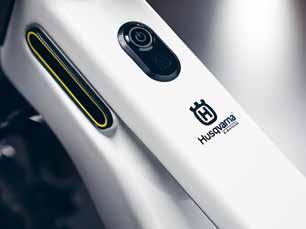
Disruption unleahes creativity?
“No,” believes Alexander Thusbass, “it’s the other way round: Creativity unleashes disruption and is hence at the root of everything.” The product designer and bike specialist is Managing Partner of KISKA Munich GmbH: a go-getter who likes to take things into his own hands but also enjoys navigating digital worlds. “Disruption is the core. But in recent years, software development has proven that groundbreaking solutions are
originating from fields that actually have next to zero concern for design.” Now what does that mean for his own work? Thusbass laughs: “The nutcase attitude designers used to be labeled with has now been elevated to the high art of business thanks to Design Thinking.” Sounds like reversed roles, but it shows where we are today: Creativity is not the prerogative of people who know how to handle a drawing pen: It’s a key prerequisite for modern businesses


and future societies. This is exactly what the KISKA brand, which founder and CEO Gerald Kiska started in Salzburg in 1990, stands for. The international studio merges transportation and product design with strategic brand consulting and thus handles assignments that in the past only management consultancies would have been deemed qualified for. That too is a sign of change. From initial research to communication, from product to service to brand identity, everything springs from the same source – more precisely, from a large team of specialists who start by studying the market, trends and technologies before the first sketch is drawn up.
A company like KISKA knows no standstill. New assignments, new fields, new coworkers are constantly being added. “We have been a ‘living prototype’ for 30 years,” Thusbass says: “ KISKA is constantly being remodeled: And it’s not because we have to. It’s because we want to.” In response to a questioning look, Thusbass explains that it’s the same with our brains: The mind loves routines. That’s how we “get our lives sorted out,” yet we become blind to change. KISKA, too, has certain comfort zones alongside “extreme curiosity,” he says. “That attracts people who are just that little bit more inquisitive.” The chase for the new manifests in the team’s T-profile: broad interest in a whole host of things with a very personal focus that digs deep: lots of nerds and geeks, specialists who allow themselves to be surprised because they know that the world is constantly changing. And they change along with it.
But what does that look like in concrete terms? For example, with regard to the transition from the automobile to the electromobil. This is where the passionate
e-biker gets quite emotional: “Is it enough to replace a combustion engine with an electric motor? Or shouldn’t we instead be questioning whether two tons of vehicle in the inner city – regardless of the type of motor under the hood – can actually be the right solution? This involves seeing the real problem behind the question. Not all clients might be thrilled with this approach. “True,” Thusbass admits, explaining that it certainly is an intense process, but it ultimately helps to see things a little more clearly. Yet for some, it’s a “brutal challenge.” he says.
Design is beautiful, but it can also be a lot of work – to paraphrase Karl Valentin. Because the spotlight is not only on a product, but simultaneously also on the whole: the market environment as well as the brand, the strategy as well as the user interface. “Holistic” is the term that used to describe it. “We engage in quite a number of discussions that are entirely unrelated to design, because these are actually strategic business discussions,” Thusbass says, smiling. “That’s what also makes KISKA a somewhat taxing partner: brand consulting plus strategic concept development.” Therefore, he adds, it is important to make sure the clients are on board with this rigorous process. And this is how over the past three decades, headphones, motorcycles, motor yachts, heating systems that “don’t belong in the basement” and luminaires came to life – not to forget Concept Cars in 36 weeks – , and most importantly: business models and brands that have endured on an international scale. KISKA thrives on restless minds like Alexander Thusbass, who completed an internship here, then became founders themselves, came back, walked out again, and are now using their creative energy to encourage disruption anew.
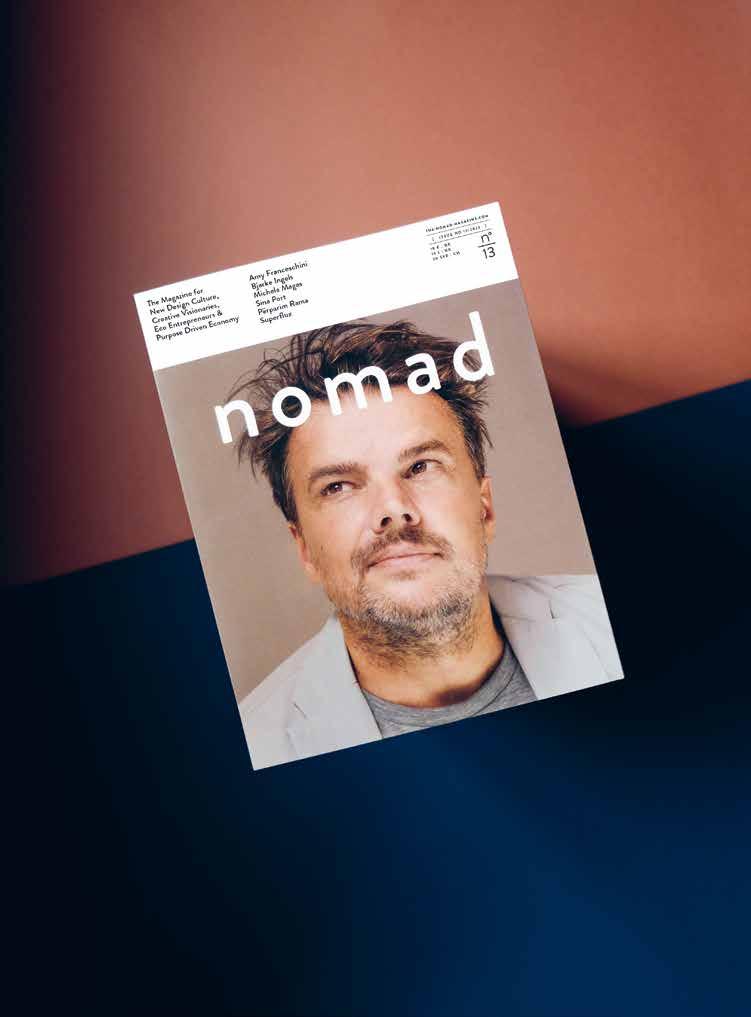
Inspired by the forward-thinking approaches of creative visionaries including Bjarke Ingels, Sabine Marcelis, Michela Magas, Barber & Osgerby, Formafantasma, Andrés Reisinger, David Chipperfield, Nendo, Junya Ishigami and many others. As a premium print magazine distributed in more than 30 countries, and a digital magazine available globally.
www.the-nomad-magazine.com . @nomad__magazine

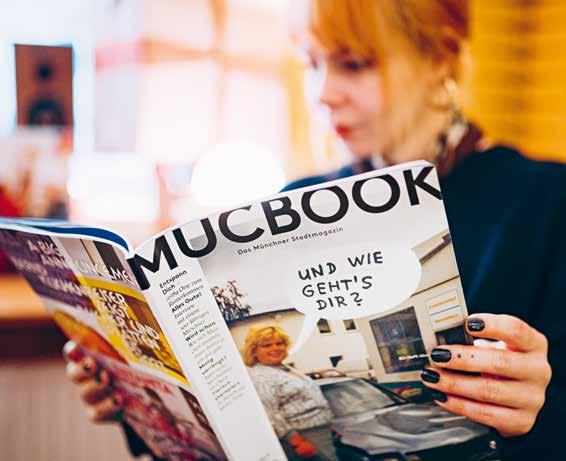 OLIVER HERWIG
OLIVER HERWIG
You are a publisher – an “entrepreneurial journalist”, in your own words. With your “MUCBOOK”, you have pioneered a contemporary format for local reporting. Who in their right mind would willingly leave the “Süddeutsche Zeitung” and say, in a nutshell: “You people have no grasp of the digital world”?
YMARCO EISENACKThat is, of course, a concept of life. I couldn’t help it. The path of doing my own thing may not have been an actual choice of mine. I guess the urge to “undertake” something new was just too strong.

MWITH MUCBOOK, PUBLISHER AND ENTREPRENEURIAL JOURNALIST MARCO EISENACK HAS PROVED THAT HIGH-QUALITY LOCAL JOURNALISM CAN ALSO EXIST IN THE DIGITAL AGE.
WHAT’S HIS DRIVING FORCE?


OH
An urge ...?
ME
... to break free from structures that you believe make no sense. And to implement instead what provides a genuine added value for people. This includes the boundless desire to simply try things out, to collaborate in networks and, of courste, to be ready to make mistakes.
OH
Hence “entrepreneurial journalist”?
ME
Precisely. I liked the term because journalists have been trained to be passive observers only. They report on the things other people are literally “undertaking”. But with this attitude, we won’t help our media world transition to the digital age. To continue providing good reporting, we need a new type of journalism: entrepreneurial journalism.
OH
Can you elaborate?
ME
Especially on the local front, we need journalists with a trailblazing spirit, who find new avenues to tell their stories and come up with creative ideas to get readers to pay for it. Newsletters, podcasts, TikTok videos or events, you name it – I believe it will be a mix of everything. We are also in dialog with a nationwide network of innovative local media, and it shows that there is a high demand for relevant and comprehensive information, particularly in the local sector. And particularly in times of change and uncertainty. Only that readers today expect it to be served to them in a different way. Most of this will happen in the digital space, but paper will also have its place.
OH
You said in an interview, the new builds on the old. And yet, you live and breathe disruption. Are you a disruptor or a builder of bridges between the old (print) and the new (digital)?
ME
I am both. The basic idea of a newspaper isn’t wrong. Trouble is that the traditional business model doesn’t translate to the new world. For more than two hundred years, advertisers spent big bucks to purchase space on paper. With the invention of the Internet, they realized that there was a much smarter way to address their target audience. Now we need a new business model, especially in local journalism, where advertising funding cannot work with online ads alone, given the relatively limited reach. Viewed in this light, disruption is the appropriate word to describe the collapse and replacement of a traditional business model. We are, of course, building on the old: As journalists always do, we too are committed to delivering good information to the people. That means we keep the foundation, but the structure we are building on top of it looks totally different.
OH
In its early years, MUCBOOK was even ad-free.
ME
Now that was admittedly a little bit crazy and a totally disruptive move: to be completely ad-free for the first four years. But instead of selling hideous and annoying popups, MUCBOOK opted to do without advertising altogether. And to this day, you won’t find a single banner ad on our site. The trend towards content marketing then became a model that suited us. But here, too, we reject requests if they are not a good fit. We pride ourselves in taking a stance based

on our philosophy: We claim to improve people’s lives in Munich with our information. I think MUCBOOK has meanwhile acquired an identity as a city improver that is being appreciated my many.
You are now expanding this business model for the ad segment to include membership fees.
ME
Exactly. We have to think in completely new terms, that is, attract readers willing to pay for good journalism. The annual fee is 50 euros.
OH
So disruption, pressure, freedom and creativity all belong together?
ME
That’s an almost philosophical question. What will unleash more
creativity: pressure or freedom? I believe that freedom can breed more good.
In addition to MUCBOOK, you have also started the coworking and creative space MUCBOOK Clubhaus, which offers affordable space for start-ups and creatives with roughly one dozen interim uses spread across Munich. Currently, also the foundation of the Munich Innovation Crew is drawing a lot of attention. Following the motto “Make Munich a better place for good people,” it houses the think tank MUNICH NEXT LEVEL next to TEXTBAU, a creative forge for communication, and BRAND YOUR STORY, an audiovisual creator studio, all under the same roof. All of your start-ups have some relation to urban development. Do you keep gravitating to the subject because we are on the verge of some major disruptions in this field?
Our cities will need to change radically as we move toward climate neutrality. At the same time, we are facing major challenges such as housing shortages, growing social inequality and the economic transformation of several industries. We want to do our part to keep the urban community united. Communication is key to convincing people to join us on the journey ahead. We can share knowledge and encourage people to make the necessary changes.
OH
So, it’s actually about ...
ME
... making the city fit for the future. With MUCBOOK and the Munich Innovation Crew, we want to connect people with each other and encourage them to embark on this journey together – with confidence and an open spirit.

CO-FOUNDER & HEAD OF DESIGN
What do you like about upheaval?
SR&TH
As much uncertainty and challenges may come with upheaval, as many opportunities we find in it. For us, upheaval above all means change, novelty, adventure, and motion: the opposite of standstill. And we actually like that a lot. It adds excitement and momentum to our everyday lives. So, upheaval triggers our creativity: routines are called into question, we start to reflect and to take action. Upheaval allows us to learn and to grow.
How do you motivate your team, and vice versa?
SR&TH
If you don’t believe in a world based on equality, you won’t find much motivation here. For us, motivation primarily feeds off our shared vision and approach to life, which is shaped by values. We founded the OH WOMAN ® design studio to help create a free and equal world. Our main goal is to facilitate encounters at eye level, to dismantle stereotypes and to face the challenges for our society.
Our expertise is the key to raising the awareness for people and topics. One advantage as a team is that there is always someone who is eager to change things. So it’s a constant give and take that shows appreciation, and appreciation is a huge motivator.
What exactly is “disruption” for you? And how creatively do you deal with change?
SR&TH
Disruption is the process of replacing what already exists or what you have learned. You are forced to adapt and reinvent yourself. Though forcing may sound rather negative, for us as full-on movers and shakers, there are positive sides to it as well: More than anything else, disruption to us means opportunities and (personal) growth. It provides the chance to move on from stagnation to action. The status quo is put to the test, the world is subjected to scrutiny, which in turn unlocks potential for new ideas. The educational game OH WOMAN® created during lockdown shows us every day: Times of change can be a catalyst for great ideas.
Robert Meinolf Börsting and Patrick Märki talk brands, disruption and creativity.



The pitch-black airlock swallows any sound. The walls are covered with sound absorbers like in a recording studio. It is a gateway to something new. Next, visitors stand in front of the large reception desk. Glass walls on both sides convey a sense of openness. To the right is the conference room. To the left, an open-plan office unfolds that accomodates more than 90 creatives from the fields of strategy, design, brand experience and brand management, from interns and senior designers to
founders. Amidst them all, Managing Partner Patrick Märki and Head of Design Robert Meinolf Börsting. There are hardly any dividing lines, only few hierarchies. They are all in the same boat.
KMS TEAM was founded in 1984, before smartphones, before social media and even before the Internet really took off. A company that does not change, or even transform, over the course of four decades usually disappears from the market. KMS TEAM is successful for its ability to bind

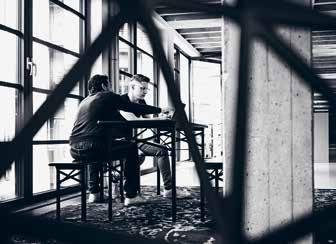
people with their missions and to keep reinventing themselves without ever relinquishing their core. That core is their passion for what they do: creating, strengthening and transforming brands. “Knut Maierhofer initially foun ded KMS purely as a design firm,” says Patrick Märki. “And that design DNA has never been lost, nor should it be.” But design has changed. It has become more complex, more holistic. The focus is now on strategy, says Märki. “We intersect with business consultancies because we don’t just design good visualization, we also create values and strategies and dig deep into the companies to do so. We are in charge of a company’s complete brand experience, sometimes also the product segmentation.” KMS covers a broad spectrum, both internally and with regard to future clients. The portfolio includes automotive groups, banks, cultural institutions and technology firms, all with equal priority. Progress occurs when knowledge transfers from one project to the next, but without ever simply copying ideas. That would just be too easy. “We use synergies,” says Patrick Märki, adding that the automotive industry has certainly benefited from that as well, given that they had previously been in charge of projects such as the Staatsgalerie Stuttgart.
The design magazine for living modern lifestyle.
But what exactly that mean? Dialogue, an honest exchange of opinions and criticism, is a must. This is what Börsting and Märki call stance. “Reviewing orders with a critical eye” also means asking which parameters are actually set to ensure messages remain reasonable, consumable and participatory, says Head of Design Börsting. “We are good at what we do,” adds Märki. “And our ambition is to keep getting better. That’s precisely what drives us. We play in the Champions League, up there with the
best.” That means embracing the new and thinking outside the box, he explains. That’s also how the team concept has emerged: different talents with different backgrounds and ages, diverse perspectives and sometimes crazy ideas. “The friction that arises from this moves us forward. We have 90 + people on staff, but the exact size isn’t all that important as long as everyone here burns for the cause.” After all, in a world that is constantly reinventing itself, inspiration can come from anywhere. “What matters is that we create the idea from within ourselves and then we make it available,” Börsting says. For KMS TEAM, designing means gaining relevance, which means co-creating the world. Naturally, this can be achieved by taking great leaps. But also by working persistently, making small improvements and taking steps in the right direction. “We are convinced that we are also changing things content-wise, that we are enabling and harnessing disruption,” says Märki.
This transformation is in full swing. Right now, the very foundation of the profession is being rattled. Artificial intelligence writes texts and creates images following simple instructions. What is KMS TEAM’s take on AI? “It’s a riveting topic,” replies Märki. “We are strongly convinced that in the future we will determine the parameters for how AI works. At that point, design will be about creating parameters.” The digital world carries disruptions that are no longer about visualization alone. Instead, they are about haptics, about olfaction, about movement or time. The big questions for KMS TEAM: “Are we the ones giving or receiving stimulus? Are we the ones adding something to social media or just taking something away?” The answer: “We want to co-create the development!”

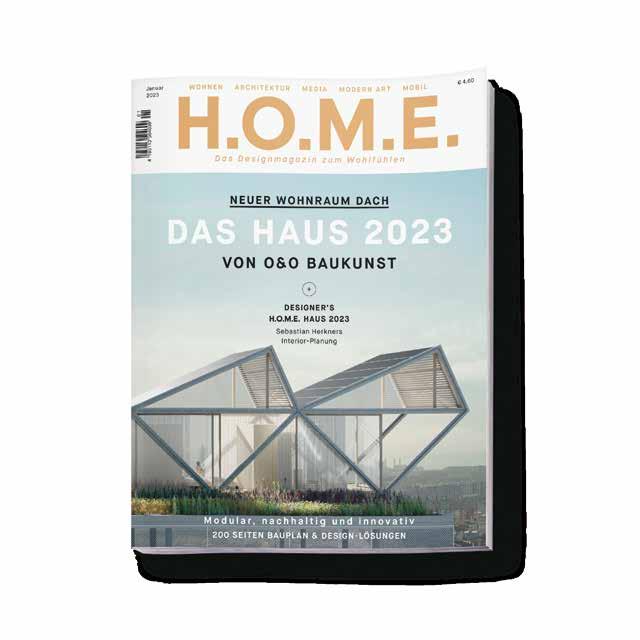
FIVE QUESTIONS FOR
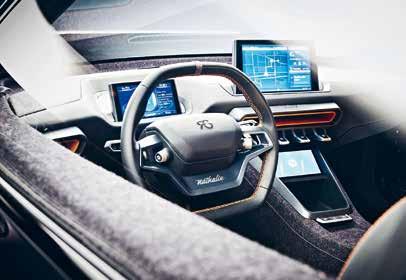
How creatively do you react to upheavals?
FG
Our industry is currently experiencing several simultaneous disruptions: electrification, autonomous driving, and a generally much more diverse understanding of mobility. The great power of designers lies in making this new and better future come to life, to test it, and to take away fear. Some time ago, we built a fully drivable vehicle with an innovative propulsion concept together with our partner ideenion: the RG Nathalie. From a blank sheet of paper to a road-ready product in nine months! Isn’t it crazy to see what can be done today and how privileged we are as designers?
When do you oppose change?
FG
Change goes in two directions: forward and backward. We only do forward gears at icon incar – with terrain reduction for tricky conditions.
How do you motivate your team, and vice versa?
attended one of our internal project reviews, it would blow your mind. It’s absolutely world class. Unfortunately, I’d have to “blitz” you afterwards. (Editor’s note: memory erasure, in reference to the comic book adaptation “MIB”).
Who is creative at your company, and when – and how does that show?
FG
At icon incar, we are driven by the desire to change and improve. This goes for all levels and all areas, such as design, development, office management or shared service. When you see the results and show real appreciation, it becomes a home run. Achieving the goal is the bottom line. And if that involves stretching the rules, so be it.
When was your business model challenged for real? And how did you deal with it?
FG
It’s a cycle. The team’s performance is extremely motivating for me, and I give them plenty of credit for it. If you ever
FG
It usually happens when a buyer calls for the first time. You better have a chew toy at hand in that moment, because that call is not about content, but entirely about power. How do you deal with it? You hold more power. Believe in your abilities and keep your cool. Don’t settle for less than your worth.
 DOUG POWELL, FORMER VICE PRESIDENT
DOUG POWELL, FORMER VICE PRESIDENT
Given your experience as IBM’s Vice President of Design: How creative are big companies when it comes to rapid change?
DOUG POWELLBig companies are not very good at rapid change. That is especially true for big old companies. But the key word was rapid change. A global company, a massive company of hundreds of thousands of people is not set up for being reactive to changing conditions.
OH
In the case of IBM, you’ve done something about it …?
DP
When we launched the program in 2013, they did not have the talent, the human skill and capital inside the company to build that sort of muscle. And this was an important part of the mission that I took on when I joined there.
OH
One of your major themes is leadership by design. How does design help in times of disruption?
DP
Our core superpower as designers is to focus on the needs of real people. That is a unique quality within a big company. The marketers are paid to think about the market, the competitive landscape, the opportunities for the business. The engineers are paid to think about how to build this. And the data scientists are thinking about the data. There are lots of very smart people doing very important things.
OH
And designers…
DP
… think about who are the people who are going to use this thing that we are going to build. What are their needs? What are their pain points? What brings them joy? What frustrates the heck out of them? And how can we create a better experience for that designer focus on the needs of a real person? So that’s a very important distinction and an important reason why designdriven companies are outperforming the market. Designers are change agents.
OH
You just described big companies as dysfunctional families. Their members don’t talk to each other. They don’t understand the various needs of the others.
DP
It’s absolutely true. It’s chronic. If you look at how big compa -

nies are organized, they typically have divisions. And over time, those organizations are naturally going to get isolated from the other parts of the business who are accountable for other things. That’s the nature of the world we live in.
OH
How about designers? What should they do?
DP
Designers are connectors. That is another of their superpower. In the best circumstances we are positioned to say, “Hey, I’m seeing something over in another part of the company that is very interesting. And I think it could help us or I think we could help them.” Let’s get the right people together and let’s compare
notes. That’s a very rare quality in big companies, and that’s something that I see designers being able to do. And through our methodology of Design Thinking or human-centered design we have a set of activities and behaviors that can really inspire that kind of crossing-over and connecting.
OH
So, it is about soft power.
DP
That is a very good way to put it. And yes, that is a very important way for us to operate.
OH
You have been training designers to act as leaders. Would you say these people are more creative in times of crisis?
DP
Yes, they have the ability for it. My hope is that design leaders in a time of pressure or crisis are going to lead through their abilities as designers. I don’t always see that. In fact, instead, I see that too many designers, when they get to a more senior level in their career, experience a moment of crisis. Something happens that we weren’t expecting. So, rather than calling on their design abilities, they pretend to be a leader, the type of leader that they aren’t.
OH
Why is that so?
DP
They see those soft skills don’t get valued in the same way in that moment of crisis. Most design leaders are in a role that they were not trained to do. And yet here we are, myself included, in these big companies with a lot of expectations and a lot of accountability. And we have to learn on the job, which is very challenging. And that is where we are right now in the profession.
OH
What is your idea of innovation in a time of crisis?
PD
Well, it’s challenging in a time of crisis. That’s not when you should be innovating. If you’re trying to innovate in a time of crisis, you’ve already lost. You’ve probably already been disrupted by the outsider. What the real challenge is, is to get big companies to build the muscle of innovation when it’s not a crisis. And to invest in it and to nurture it over time. So that innovation becomes a natural way of being and of behaving.
OH
You have trained people in the company to understand that …
DP
… innovative, creative thinking could happen naturally rather than happening only in a special way. At IBM, we needed to get it into the DNA of the company. Ultimately, we were able to train over half of the company in this in this practice.
OH
What kind of methods were used in this program?
DP
The key is behavior. And the key activity is cross-functional collaboration and co-creation: teams of people who do different things, people who have different skillsets, different backgrounds, different priorities, different ways of thinking. The Design Thinking methodology brings those different people and points of view and expertise together and gives them a set of activities where they can all participate in an equal way. With a focus on that human being that they’re all building for.
OH
If I had attended your program ...
DP
… you would have come away with a set of skills that would help you pay attention to the needs of people. We weren’t talking a lot about disruption. Because, hopefully, when teams are operating in this way, they are ahead of disruption. We’re hoping that they become the disruptors internally.
OH
“Why disruption unleashes creativity” is this year’s motto. But you turned it around: “Creativity unleashes disruption.”
DP
Yeah. That’s an interesting way to view it. You can play it both ways. I think when we can become the disruptors rather than the disrupted, that’s the win.

DEAN OF THE DEPARTMENT OF DESIGN, PROFESSOR FOR DESIGN BASICS AND PROJECT-BASED APPLICATIONS
VICE CHAIR OF THE DEPARTMENT OF DESIGN, PROFESSOR FOR DESIGN AND MEDIA THEORY, DESIGN AND INNOVATION CULTURES
Do we talk too much about disruption?
BS&MF
We currently find ourselves in an era of profound upheaval. Our traditional systems are being radically transformed by social, cultural, technological and ecological shifts. This situation calls for the cohesion of science, politics, economy and society. In the face of global challenges, disruption appears ever less as a threat to the status quo, but rather as a necessity given the imminent transformation processes.
What exactly does “disruption” mean to you?
BS&MF
Design is both disruptive and preserving. It unfolds, improves and sets the stage for innovations. At the same time, it nurtures and enhances prevaliling identities and traditions. The opportunities inherent in the current changes must be seized with an open mind and networking competence. With its work practices and communication skills, design is fundamentally involved in moulding the change: as a driving force on the way to a high-performance society that embraces research, is socially aware and future-oriented.
How creatively do you deal with disruptions?
BS&MF
The strengths of design lie in dealing with not knowing, being incapable and failing. Handling uncertainty and ambiguity is an immanent ingredient of the design process. Doing so, we train an attitude that cuts much deeper than most Design Thinking workshops.
In Germany, design is oftentimes still regarded as a mere embellishment discipline that makes innovations attractive and socially acceptable by means of aesthetic staging. However, if design is integrated into the innovation process right from the get-go, it can serve as an intersecting discipline and a powerful creative tool to create innovations, initiate upheavals or react to them. It is therefore crucial to promote design research more vigorously in Bavaria and to make it more compatible with other disciplines as a knowledge culture. Our knowledge culture is special in that it interrelates thinking, feeling and doing, works in both a visionary and a participatory way, and sets and transcends boundaries. Hence, at this year’s mcbw, for the first time all of Bavaria’s design faculties will join forces to address the topic of design research in Bavaria – in an event at the Faculty of Design of Hochschule München. More at designimzeughaus.hm.edu.
SP
How do you actually refer to it: challenge, task, change management, problem, upheaval, or would you rather go with disruption?
As a consultancy, rpc – The Retail Performance Company – primarily deals with challenges that derive from the problems or tasks of our clients. If we look back at the pandemic, these issues can certainly be perceived as disruptive, as upheaval – for example, when the stationary retail sector suffers a sudden drop in customer numbers and store operators fail to offer online services.
How do you deal with upheavals as a company?
SP
For a modern management consultancy, upheavals are the spice of life. To be able to anticipate them, you have to keep track of long-term trends and have a nose for technological developments and social currents. The pandemic-related lockdown has put traditional retail business
models to the test. Consumers were very fast to embrace digital business models, but for many retailers, the paradigm shift was too big and their response time too long. For rpc, it was already clear in 2021 that the frequently cited end of shopping malls and physical retail was not an option. So we developed a vision of the Retail Multiverse, a space where digital business processes and physical experiences complement and determine each other. We talk about the seamless Omnichannel Retail, the smooth interlocking of business and process fields.
What role does creativity play in your company?
SP
Creativity is a key qualification for rpc. Future-proof solutions require an agile approach that creates new spaces for thought and action using changes of perspective and tools like Design Thinking. rpc has its own design department that develops specific solutions, both for the customer journey as well as the physical experience of a showroom.
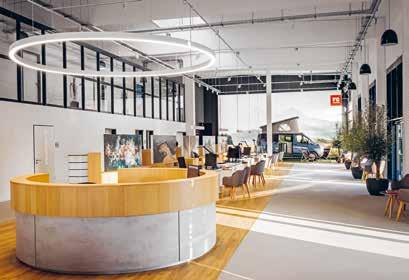

OLIVER HERWIG
WE ARE NOT SAVING THE PLANET. WE ARE CHANGING SOCIETY.
Leyla Acaroglu, Creative Explorer 2023, on the power of design and disruption in a
This year’s mcbw theme is “Why disruption unleashes creativity”. Would you call yourself a disruptive force?
LEYLA ACAROGLU
Oh yeah, I have no problem with being called a disruptive force. When I studied design, I was interested in creativity. I thought that this would be a really fun career versus sitting in an office doing boring stuff. And I learned about the fact that I was going to have big impacts on the planet by the choices I made. And
that really freaked me out. I realized that I loved this profession, but I felt ill equipped to learn how to do it well.
OH
So you studied sociology …
LA
... and became a social scientist majoring in sustainability, because I felt these worlds combined will make me much more capable of designing beautiful things that make the world work better. In the end, my design practice has been designing interventions like talks or games or learning curriculums for Fin -
changing world.
land and Thailand. The types of things I design are intentionally disruptive by force, they’re trying to be playful and fun and engaging and rewarding.
OH
Why is it so?
LA I just like to create things that make me happy. And then I think that they’ll also make other people happy. And when we are happy, we are more open, more receptive, we are more creative, and we are more likely to collaborate with others. And those are all the secret sources that we
need in order to solve the world’s problems.
OH
Are designers somehow special when it comes to creativity?
LA
Well, I don’t know what you mean by special. Like …
OH ... Exceptional.
LA
Yeah. Unique superpower. I think the most incredible thing about design and people who have been trained in one of the design professions is that they learn to pull things apart, break them, to then make them better. And so actually, the whole design profession is really about not just iterating on something that exists, but to figure out how you can push the boundaries of achieving the functionality and delivering the value that the product or service has to bring to the economy and to people.
OH
There is a lot of different parameters designers have to meet.
LA
They have to be able to make it functional, safe, accessible, desirable. And in my view, all good design is 100 % sustainable and circular as well. So in one way, that is a pretty special skill. But I think that design is a universal skill set. Design is the ability to
transform the things available to us into things that help us with our lives and make the world better. Most design that you are interacting with in your day to day life has been designed so well that this experience is frictionless. So the only time you notice it is when it is bad or boring or broken.
OH
Would call this experience disruptive? When something doesn’t work, when it disrupts routines and makes us wonder …
LA
Well, that would be one way to use the term disruptive. I don’t think by its nature, design is disruptive. I think that there’s plenty of design that is literally just servicing industry, servicing the economy. Disruptive innovation is a theory by Clayton M. Christensen, 1997 popularized by his book “The Innovator’s Dilemma”. He was promoting the idea that stagnant or structured companies get easily disrupted when other people, whether it be startups or even other companies in other sectors, come in, see a market opportunity, figure out how to do it better, and then literally topple the other company.
OH
And your concept of disruption?
LA
When I promote disruptive design, it is about understanding the whole system that we’re op -
erating within: understanding all the agents and actors and elements and parts like an ecosystem to then identify the areas that the design intervention, be it a product or service or system, can affect and disrupt positive change within that bigger system.
OH
So it’s quite a different mindset.
LA
Disruption isn’t about messing things up. It’s not about making somebody fall off a chair. It could have an element of disrupting the status quo, meaning if you’re used to performing particular behaviors in a particular way. But realistically, disruption in the design world is about using our knowledge and skills to be able to create goods and services and business strategies and entire new concepts that move us to a better state.
OH
In order to do so we’d have to …
LA
… disrupt the status quo of a linear and unsustainable economy that we know is responsible for climate ravage, plastic waste crisis, etc. We are taking those problems and turning them into opportunities by understanding the full system, using the design skill set to create these beautiful, functional and effective solutions that meet human needs, but without doing it in a destructive way.

OH
Positive disruption would then be about overcoming the destructive nature of our current economy.
LA
Very good point. So the difference between innovation, iterating on the existing paradigm and disruptions is that you are completely dragging the industry somewhere else.
OH
You once called design “the silent social script that influences everything”. Do we have to unlearn our habits in order to save the planet?
LA We are not saving the planet. We are changing society to live within the means of the planet. The planet is fine and would be much better without human intervention. The idea that humans are saving the planet speaks to an old idea that humans are above nature, that we don’t rely on it for our daily sustenance and survival. So I really love the idea that we are all actually changing the world every day through our actions or the things with which, by the way, we interact with other people and the values we hold. We all have the capacity to help transform our society, to live within the means of this beautiful, life sustaining planet.
SCIENTIA PHD
CANDIDATE, UNSW SYDNEY ART AND DESIGN

OLIVER HERWIG
You are a trained scientist, artist and designer.
CATHERINE SARAH YOUNG
I was actually a molecular biologist cloning antibodies against breast cancer. But I didn’t want to be stuck in the lab all day. So, I studied art in Barcelona, science in Manila, and design in the School of Visual Arts in New York. Design taught me a lot of things about how to communicate ideas effectively to another human being.
OH
But you focus on being an artist …
CSY
... This is because as an artist I’m really free. I try to keep an open mind and make sure that I’m not furthering the divisions in society. I try to bring very inclusive spaces to my work, for example, with perfumes. We all have different memories of the same scent. I love it because it embraces the difficulties in sharing different stories. Maybe even a difficult subject like climate change. A lot of the images we see in art, like polar bears dying,
The Arctic map is used as a chessboard with melting ice figures. These contain toy soldiers with the national flags of the countries responsible for the climate crisis.


ICE CHESS (2021)
THE WEIGHING OF THE HEART (2021)
or the planet in flames, I feel that people are tired of seeing over and over again. We need to disrupt the story that we are telling ourselves: That it is hopeless.
OH
Sustainability is about to become meaningless as it has been repeated so many times without corresponding action following ...
CSY
We all have very different perspectives on how the planet can be sustainable. So I think those words are not completely meaningless. They do mean something, but at the same time, I
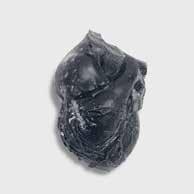
Ashes and other organic remnants of the ravaging Australian bushfires are used to create small sculptures like this depiction of an anatomically correct human heart.
think it’s also good to critique why we are putting human beings at the center. That was the problem, right? Because we thought we were at the top and bigger than anything else. When I think about the practice I do, I like using the word subversion, not just disruption. I often talk about what subversive imagination is possible in the arts.
OH
You once said, disruption fosters creativity. Do we have to leave our comfort zones to be confronted with different opinions …?
CSY
Yes. I’m trained in martial arts, so it is a sort a battle. When you disrupt a field in design or in business, you’re actually bringing another set of tools to work with. And when you expand your vocabulary, you can create a better story, a more diverse story. And when it comes to saving the planet, you have more tools. Disruption is quite a tricky word. A buzzword.
OH
That’s why you speak of subversion.
CSY
Yeah. I’m used to being the one on the fringes, being trained in various things. Transgressing is fine, but there’s something to be learned from all people. And that’s so much bigger: We have to come together and actually collaborate and learn from each other. Collaborations are especially important in design and business. We need to have people whose task it is to think beyond the box, because the boxes are very tiny.
OH
You even have come up with a list of subversive imagination. Like “learn another language”.
CSY
I try to think of what my art will do to the average person. I’m not saying we should all be artists, but I do think artists have a way of reframing anything, whether it’s an early catastrophe or the future. We all should be writing our futures together. A lot of the good things have eroded on the planet, even our relationships with each other. This has a lot to do with materialism, right? We lost focus on the things that are truly important. And I’m telling people that there are other stories out there and there are other ways of looking at the world.
OH
Speculative design can be real world design. You proved that in Beijing, when you had to wear a facemask you designed years ago.
CSY
I’ve been in so many places where I had to wear a normal facemask. So I was checking out ten, 20, 30, 50 years down the line. How would that look? Basically, I was taking things that we actually have in the present and layer future things on top of that. Speculating is something we can add to our critical discourse. This is elastic imagination, something we can exercise. And in a way, you can look at art as the gym for an elastic imagination. Artists are part of a longterm solution.
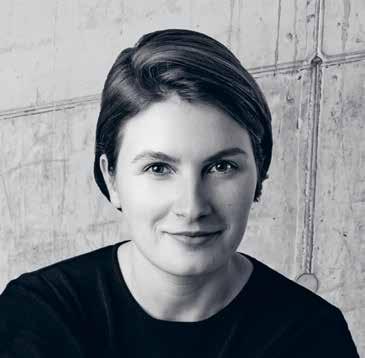
HEAD OF BUSINESS DEVELOPMENT AT THE START-UP CONCULAR
What
if circular construction were to become reality? If buildings were conceived and built holistically: from creation to dismantling and recycling? Concular is taking this approach. The start-up thinks in circular concepts, leaving linear construction behind.
OLIVER HERWIG
Concular is successful because the world of construction is undergoing a radical transformation. How would you describe this shift: as a reorientation? A turning point ...?
ANNABELLE
VON REUTERN
Reorientation sounds about right, because in terms of how we build and which materials we use, good work has been done in the past. But that was a long time ago and a lot has happened since then: capitalism, economic growth and industrialisation: a simplistic building approach means going back to what actually serves us.
OH
Aren’t you getting a little tired of the word “disruption”?
AVR
Actually, I don’t. I mean, we are without doubt a disruptive startup. Compared to many others who focus on optimising existing processes, we seek to restore past processes. But is it really a disruption when the knowledge has been there before? Maybe insofar as digitisation helps us create and optimise new value chains.
OH
Does this disruption encourage particularly creative solutions?
AVR
Definitely. A lot is happening that motivates me to keep going, because we are not alone in this. The question is always: from which source does creativity arise? And why? Out of necessity, perhaps? Rage? Discontent? What is certain is that the
climate crisis causes us to no longer accept moving sideways, but shows us the need to move forward instead.
OH
Where is the creative element in that?
AVR
It’s the creative procurement of materials that have been used in buildings before. We take a different approach to planning and building. Form follows availability, which naturally breeds a great deal of creativity, much like a collage. What makes us creative is that we can picture pro -
cesses that don’t yet exist, that we can picture a building culture that doesn’t yet exist, that we can picture collaborative planning and building processes that don’t yet exist.
OH
What is it that you do differently?
AVR
We never relinquish our power of imagination. We take to a flight altitude where things can come into being and don’t get dragged down by conditions, regulations and laws. These didn’t just fall from the sky, someone thought them up once, so they can be altered again to serve a more useful way of doing things.
OH
And how does that work?
AVR
We are pioneers of the resource and building revolution. And we seek to inspire as many stakeholders as possible to join us on this path. We can’t do it alone.
OH
Sounds exhausting.
AVR
It is! But it’s also a lot of fun. The flow of creativity and energy works better in a group. Planning and building is a complex and stressful business. But this new goal, the building revolution, is a powerful motivator.
OH
What are the biggest road blocks?
AVR
Issues like warranties, logistics, storage ... But we prefer to talk about solutions. About taking the next step to ultimately being able to coexist peacefully within our planetary boundaries. That is the goal: we want a better world that is worth living in for all of us.
OH This takes ...
AVR ... energy and guts to do things differently.
OH
How far away are we from an actual circular construction policy? You’re laughing!
AVR
I am, because right now that’s still very far from happening. These are all pilot projects, small potatoes compared to all the projects that are being planned conventionally. The main obstacle is still the mindset of too many people. I’m not trying to play the blame game. We all have to move, to change. The same applies to regulatory issues, so that the use of secondary building materials can become the new standard.
OH
What are the next necessary steps towards a circular construction?
AVR
Implementing what has been stipulated in the coalition agreement. That means introducing materials and building passports, as well as including existing buildings to ensure a mandatory “pre-demolition audit” for every de- and reconstruction project instead of simply submitting a demolition request. Also, simplifying the approval of secondary building materials.
OH
So how creative do we have to get to win the future?
AVR
We are already creative. We just have to flip the switch and get out of our own way. And that’s what I wish for all people to do, because we are all creative.
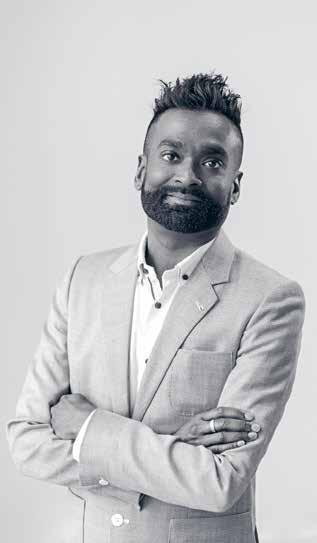
DIRECTOR AT THE HELEN HAMLYN CENTRE FOR DESIGN, RCA, SPECIALIZED IN INCLUSIVE AND UNIVERSAL DESIGN
The book you wrote last year, “Creative Leadership Born from Design”, shows the value of creativity in its very title.
RAMA GHEERAWO
Creativity is where many things are born from. It’s where our endeavours are born from. So, you know, I use the word design and creativity interchangeably pretty much because design is the profession. Creativity is a human action or value. So it lives at a universal level. Creativity is often missing. You can have all the empathy, all the clarity in the world. What do you do with that? How does it deploy? How does it land?
OH
From a designer’s perspective: Would you say diverse teams actually work better than others?
RG Absolutely. Diversity in all its glory. And of all people, management consultancies do this research like the McKinsey 2021 diversity report. Just binary diversity meant over 25 % increase in productivity. If you look at ethnic or racial diversity, that was 35 % in 2018. Now it’s closer to 40 %. But, you know, we can get all these markers of diversity, and I like to think of this a primary for which age, ability, gender and race. There is a springboard for us to look at diversity, get those full right and you’ll start to get others right.
OH
Such as …
RG ... class, such as geography, such as economic circumstance because it’s so intertwined. But you get those four right, and you actually start to incorporate a wider view of diversity.
OH
You often talk about change, but you never mentioned disruption in your book.
RG
Yeah, it’s not there.
OH
What is the reason for that?
RG
There is so much written about disruption. And actually, what people want is balance and peace, especially today. Change is disruptive. Things are disruptive. How do you address them? And when I talk about balance, we don’t treat imbalance with more imbalance. I think balance is a dynamic thing. A running horse, a walking human, a bee in flight. All of these things are in balance. But a plane, for example, is making a thousand micro adjustments just to be in balance. It only flies at, you know, 500 miles an hour because it’s in balance. There’s enough disruption in the world around us. Don’t be a disruptive force yourself. Be a force of balance.
OH
You also shifted the focus from the “I” to the “we”.
RG
That’s right. There’s an interesting thing, you know, if you focus only on the I, only on the ego, you walk alone. But if you think about the collective, we, you have to move from that culture of me to a culture of we. Because if you have that culture of we, you never walk alone, you walk together.
OH
And how about the managers at the top, the so-called executives?
RG
If they stand in their ivory tower and say it’s lonely at the top, something is very wrong. It’s not
Rama Gheerawo is an expert in inclusive design: His team and he develop products and services that do not discriminate against anyone and design places that naturally include people. His current focus is on leadership that understands diversity as a strength.
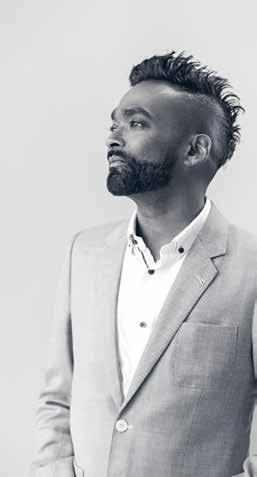
that leaders should be lonely at the top. If you walk with the collective, you walk together. And that’s a really important thing. Often, you’re walking behind people, behind your team because you’re following a pathway, following information, following advice. So Tim Brown puts this really nicely. He said: Leaders today have to be multi-perspective and multi-dimensional.
OH
And that’s why you proposed this triangle of empathy, clarity and creativity. Does creativity come last or is it more like a basis for everything?
RG
Creativity was an instigation point for these three values. I mean, creativity quite often is the last to be deployed, but it lives throughout. So if you think of empathy, clarity and creativity as the tripartite model, they live together. They work together. I would say, clarity is the head. Empathy is the heart. Creativity is the hand.

PROFESSOR FOR DESIGN AND TRANSDISCIPLINARITY AT TUM
Disruption is the buzzword of our time. But how can change succeed with the help of design?
ANNETTE
DIEFENTHALER
The best results emerge when enterprises don’t just hire designers to materialize a creative process, but instead, proactively engage in a transformation process to put themselves on the map as a resourceful, learning organization.
OH
And what does that look like, in concrete terms?
AD
With IDEO, I have applied design in the field of education and schools for many years. With the
Innova Schools in Peru, we designed a private school system that offers a high-quality and affordable alternative to the oftentimes deplorable public schools. And with success: the initially five schools grew into sixty-three over a decade.
OH
How did that happen?
AD
Because from day one, the Innova team perceived itself as co-designer. And because we incorporated the challenges inherent in the Peruvian context into our design process.
OH
How would you characterize these schools?
INNOVA SCHOOLS
The implementation of the Innova School System in Peru was such a success because the Innova team actively participated in the in the design process. Today, more than 50,000 students in three countries have access to high-quality schools.


AD
Three things are crucial: the combination of independent studies and group work. Students study partly online, which grants them access to high-quality material. Then they consolidate their knowledge in the group. Then they also do a lot of project-based work. With a variety of pre-planned curricula and further development opportunities, teachers co-learn along the way, which ensures a high level of proficiency. And everything is based on a meticulously calculated business plan to keep costs down.
OH
That sounds like a lot of change. Yet some people are reluctant to leave their comfort zone.
AD
In that case, I meet them right at their vantage point with a commonly developed goal. This starts with listening. You see, it’s not that people don’t want to change. But change can be scary, and we have to address these emotions in the design process.
OH
Can you win everyone over?
AD
Not everyone, but the majority. And sometimes we need to pull back a few steps from what we as designers would like to see and instead see first how people resonate to our ideas. If we do that, change can be designed in a way that doesn’t feel like a loss. If you take people seriously, it’s actually not that hard.
OH
Is this what transformation design is about?
AD
My ambition is a very broad notion of design. Even a simple toothbrush includes more than just medical aspects of dental hygiene. What happens when the item is no longer used? What are the working conditions of people involved in the manufacturing process? Everything needs to be thought in larger concepts, involving the environment and the people. What matters is that people with specialized knowledge can participate in design processes. That’s when transformation can happen. Designers can never get there on their own. Cooperating with people is the key. Reframing a complaint into a desire – that is a helpful version of creativity which will support us to evolve as a society.
OH
What do you expect from entrepreneurs willing to engage in such a process? Or is this what it’s all about: getting involved?
AD
That’s it. First and foremost, I expect them to be aware of the need to embark on this journey together. Design is often perceived as a service, which isn’t entirely wrong, but it doesn’t work in isolation. If entrepreneurs just lean back and fold their arms, things usually don’t get very far. Openness, the will to change and a sense of curiosity are essential to the process.
OH Are designers particularly good at embracing change?
AD
I have learned about myself that I am not happy about the current state of the world. And I have found that this is what drives many other designers as well: a general disenchantment over how things are right now, coupled with an almost hyper-optimistic belief that it is possible to change that. It takes both. After all, we invented ourselves how the world works: every law, every system, every ritual. That means we can also change them.
OH
Does design always have to save the world? Can’t we just dial it down a notch?
AD
We as designers can’t save the world all by ourselves. So we might want to humble ourselves a little. However, with everything we design, we should ask ourselves: How does that affect other people, and what responsibility do we have for the planet?


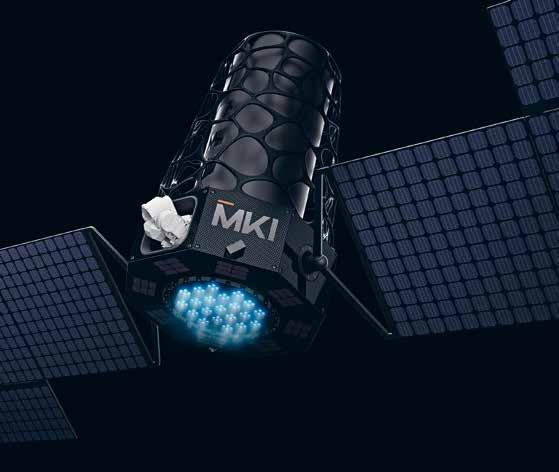

supports start-ups and companies all the way from the initial idea to production. How does it feel to be creative for others? A conversation with founder Niclas Fritz.
Are you more creative under pressure?
You can’t develop any product at all under time pressure.
OH How so?
NF
Because we are dealing with certain limitations from the first prototype to series production. It takes months to manufacture tools alone. We can’t do magic, but we’re still very fast.
OH
So, creativity means ...
NF
... to develop a product that can be used intuitively.
OH
How does BatchOne do that exactly?
NF
We support startups and other companies all the way from the initial idea or first prototypes to product design and production. Unlike our competitors, we have all the core competencies inhouse. We don’t just focus on design and engineering, we also take on all business issues, which includes addressing the issue of the supply chain. We want to help startups develop the first batch in the factory. Hence our name. We are now being ap -

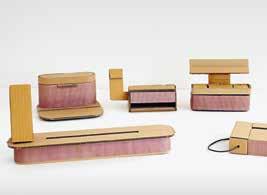
proached by more and more midsized companies, such as Lamy or Playmobil.
OH
That’s quite an extensive service spectrum ...
NF
... and already in the prototyping process, we make sure the manufacturing costs of the product are as low as possible. Because later on, startups and other businesses have to recoup the development costs. That can quickly add up to 500,000 euros.
OH
Why not just develop your own products?
NF
Because we are being swamped with requests. We’ve been building our company over a period of seven years, without investors. And I hope that one day we can invest in startups ourselves or manufacture our own products. Our current focus is to keep building on our business and further optimize the processes.
OH
A typical request involves ...
NF
... an idea or a prototype, which oftentimes has been patched together. I don’t mean it in a negative way at all, but it takes quite a number of features to come up with an all-in-one solution.
OH
And then the stripping-down process begins?
NF
Our goal is to turn it into a product. That’s why we put our heads together. In the exploration phase, we scrutinize every single feature: We don’t just go for usability, we also consider the right chipset and the suitable software architecture.
OH
What do startups and other companies underestimate?
NF
The biggest mistake is to neglect product design and usability. For most businesses, design still ranks at the end of the development process.
OH How does it show?
NF
It starts with mundane things and simple questions: Do I operate the product via the app? Does it have LEDs or buttons? And what about the charging? If you are smart about it, you can avoid unnecessary costs because the product has fewer components or combines specific modules.
OH
So, clever design saves money?
NF
Without doubt. Design is holistic. We ensure a time-efficient manufacturing and also consider the service concept, because every product breaks down eventuall. So how can it be fixed? And do customers need a service structure? If you put some thought into this, it will save you money.
OH
You manufacture ...
NF
... mostly in Europe. We always
have, and we’ve been ridiculed for it. But if a startup produces 5,000 or 10,000 units in Asia, they have to fly there. This entails high costs and communication issues, so that ultimately it often is cheaper to manufacture the product just around the corner.
OH
We initially talked about time pressure. How long does a development process take from the first spark to the finished product?
NF
About 12 to 18 months. Sometimes we are given eight prototypes and are told that they are 90 percent finished. But it’s actually only 10 or 20 percent. So in many cases, we have to start all over again. To do so, we have a team of 40 people with expertise in industrial design, mechanics, engineering, electronics development and software. Five of them alone are in charge of finding production partners, deal with certification and set up entire logistics chains.
OH
What should we prepare for in the future? What’s the next big disruption?
NF
Hard to say. All areas of life become smarter, with more electronics, more sensors. It seems inevitable. Trend reports always claim, “Tomorrow, the novelty will be everywhere,” but then it takes longer before it does appear out of the blue and you wonder how that happened. Our job is to develop useful products. Yet at trade shows I often see the very opposite, and I always provide honest feedback. I mean, these are founders and family-owned businesses. They don’t just pull out. They will most certainly be back in six month’s time with a better idea.









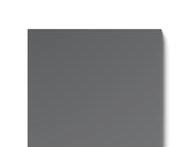
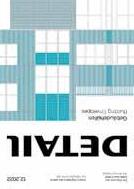


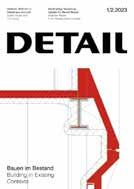




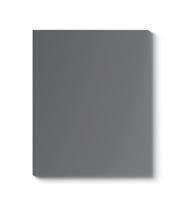


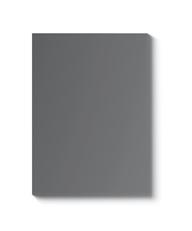



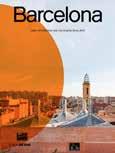


 Danusch Mahmoudi, Managing Director of Designit Germany
Danusch Mahmoudi, Managing Director of Designit Germany
Being edgy is good. Very good, actually. “After all, we get paid to be edgy,” says Danusch Mahmoudi, who has headed the Munich Designit studio for three years. “Our clients don’t want yeahs-sayers, but partners they can lean on to meet the challenges of the future.” And plenty there are. Transformation has caught on in the German economy. Digital and organizational changes affect all business ar-
eas, even entire business models. Design plays a key role in the process, and it goes far beyond functional objects. “In the past, we were tasked with designing, say, a medical device,” Mahmoudi explains as he tours the studio. “Today, it’s about interconnecting products and services in an ecosystem.”
The Munich studio illustrates the transformation of the world of work: lounge areas alternate with noise-proof retreats, and a long table encourages people to eat together. Collaboration and flexibility are also key features of the Designit working model. In a playing field dominated by technological developments, global crises and social change, companies need to continuously adapt. Mahmoudi describes it like this: “Companies as well as many stakeholders feel that something new is needed.” However, no one can say what exactly that is, he says. Their job is to identify the people’s real needs. To do so, they involve Designit in the design process from scratch, bringing all stakeholders to the table, such as users, employees from different departments and numerous other experts. “Hierarchy-free. Prejudice-free. Hence design is more and more about designing a process than an artifact. For us designers, our primary role is to listen in order to subsequently implement the ideas that have been developed cooperatively. This participatory approach is rooted in our Scandinavian corporate DNA, which has always put people at the center of its design.” Designing just for the sake of it, he adds, practically doesn’t exist anymore. “We live in an era that confronts us with such complex issues that designers can no longer shape them on their own,” states the studio director. “The creativity of our time is called participation.”

The strategic innovation consultancy Designit was founded in 1991 in Aarhus, Denmark, and has been an independent brand of Wipro Limited since 2015.
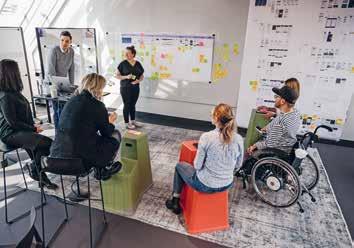
But what does this collaboration look like? Pens and stickers, post-its and play-doh like at a Design Thinking workshop? “Not exactly, but it's not entirely wrong,” says Mahmoudi. In the healthcare sector, for example, the focus lies on the direct exchange with doctors, patients and nursing staff. That’s how solutions emerge that hold added value for everyone, he says. “Our Designit motto is: Form follows humanity.” Through exchange, ideas are conceived and then discarded again when a better one comes to pass. Design grows with the experts involved. And because in our times design means permanent change, the focus often lies on innovation and innovation support.
We now stand in front of a fully automatic coffee machine, another Designit creation, and treat ourselves to two espressos. Here, too, the coffee machine is part of an entire business model and not just a mere design object. The interaction with users is important, explains Mahmoudi. They should experience the brand holistically and get excited about it. Of the approximately 700 “Designits,” 34 are based in Germany. Sometimes they join forces with other studios. In the health sector they are currently collaborating with colleagues from Oslo and Madrid. “We see ourselves as a community,” says Mahmoudi, “with Designit Germany we are kind of a Gaulish village. Each Designit village has its own very particular culture and operates for the most part independently. But when the Romans appear at our gates, we team up.” The Romans? Those are the big projects, he explains, where they pool the best expertise from all the studios. And his role is that of Majestix? “No,” the trained graphic designer chuckles. “I’m more of a Miraculix, someone who works out the chess moves and keeps realigning the focus again and again.”

What role does creativity play in your company?
MS Designworks is the BMW Group’s innovation studio, which also provides services for customers from other mobility sectors. Creativity plays a vital role, as it’s our ambition to deliver “outside-in” perspectives and, consequently, innovative solutions. We believe that in a complex world, better and more useful solutions for the future emerge from opposing views and positive friction in the creative process. Thus, we perceive ourselves as “agents of change”: We love change, and we see changes as an opportunity for better creative solutions.
How creatively do you react to upheavals?
MS Mobility entails more than the car. Hence we scrutinize infrastructures and observe cities. Since 2020, we have been studying the interplay of architecture and mobility in partnership with the Gensler architecture firm. In doing so, we are exploring how the urban planning of the
future can become more flexible: How can we respond to the fact that the old binary model that used to distinguish between indoors and outdoors, between work and home, between public and private space is being replaced by a more organic, more intricate, and more hybrid paradigm?
How do you deal with disruption?
MS
Design can manage disruption by cutting through complexity and connecting only relevant aspects in approaches for solutions that hold the potential for innovation. By taking creative long jumps (visions) and developing scenarios, design can convert disruption into order and bring its potentials to light. But design, above all, is “human-centered”. We always engage in personal contact and exchange with users, customers or influencers. We don’t just want to listen and observe. We want to develop and be creative together in order to design even better, more targeted solutions.
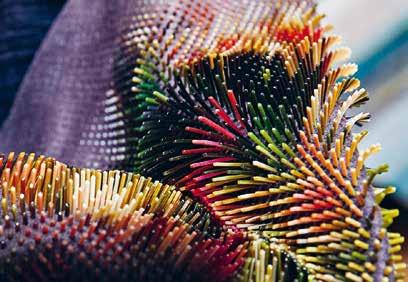

New Order shelving system: modular design for endless application variants.
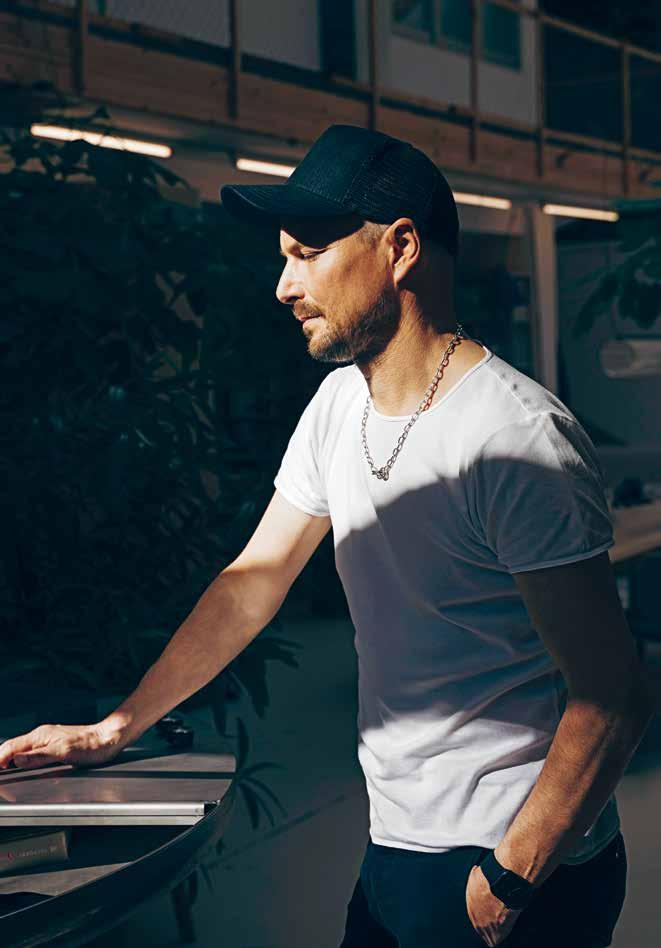
Star designer Stefan Diez on the allure of the unexpected, his longstanding collaboration with HAY and the shift towards a circular economy.
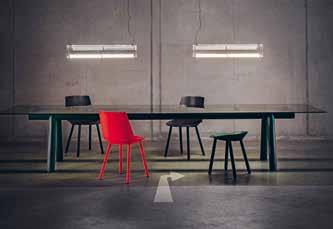 OLIVER HERWIG
OLIVER HERWIG
What qualities do you attach to HAY?
STEFAN DIEZHAY is a modern furniture manufacturer who approaches projects with tons of imagination, confidence and joy and is always ready to come up with some pretty crazy stuff. And that’s what appeals to us.
OH
2012 marked the beginning of the cooperation with “New Order”, a shelving system made of powder-coated aluminum: functional and clean, designed as a system.
SD
With “New Order”, our idea was to create a modular kit that would provide structure to spaces. We designed it in such a way that anyone can assemble it themselves. It’s a good basic system that works both for the home and the office.
OH
How did this cooperation come to pass?
SD
Serendipity. Rolf Hay and I somehow got stranded in Singapore and met for a beer. That’s when he asked if I would be interested in designing a chair. That chair never actually materialized, but somewhere along the way we got “New Order” off the ground, and when Rolf laid eyes on some of our sketches, he immediately saw the potential: a low-key system that would move HAY closer to the realm of architecture.
OH
Rolf Hay once said that he loves the unexpected in art. How does that translate to design?
SD
The unexpected is just awesome. For me, surprises have a completely positive quality. A quality that I deliberately try to induce, or even provoke.
OH
Why is that?
SD
The element of surprise successfully captures the audience’s attention. Then, we can tell a story.
OH
So, in that sense, “New Order” had it all right from the start.
SD
It was a huge surprise, but also not an easy project. For HAY,
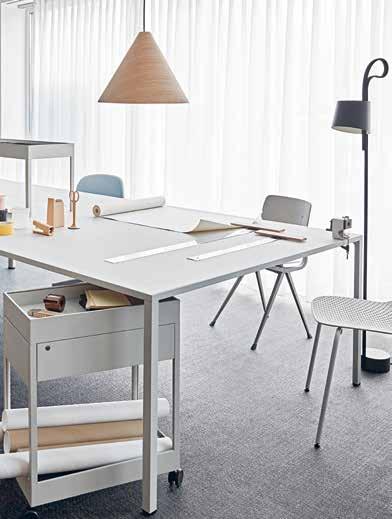
“New Order” paved the way into the project business.
OH
Back to serendipity and disruption. Is that something that can be planned for furniture?
SD
The expected is fairly easy to identify. If you know where the expectations lie, you can provoke the unexpected. I mean,
we are all constantly weighing the costs and benefits against each other: Should I take the subway or the bike? The question is always: Is it worth the hassle? And what do I get in return? That triggers fantasies. When we find something appealing, we literally go for it. It’s no different with furniture. So we have to offer something that entails a genuine surprise.
OH
And yet, classics have gained huge popularity over the past 20 years.
SD
It’s basically a matter of security. First and foremost, security in terms of taste, and second, security in terms of investment. You can’t go wrong with classics. What’s more, you can tell just by looking at them that they were made with a lot of love. Which can’t be said about all of today’s products.
OH
Do you have classics in your home?
SD
Not a single one. I mean, there are already so many of them out there.
OH
What about contemporary furniture?
SD
Personally, I don’t think the past 30 years in design were particularly glorious times. While there have always been some great products over the years, the greatest evolution is yet to come. Design is still too deeply affected by globalization due to outsourcing and production in cheap-labor countries.
OH
So, are there any revolutionary developments in furniture design? The sustainability turnaround, perhaps?
SD
Design has undeniably hit the point where it needs to reinvent itself. It takes a very special breed of companies to do that. And a paradigm shift, a loud call from the legislators to finally put recyclable products on the market. Everything else will disappear from the market at some point. In this respect, we can ex-
pect a giant leap forward in the design field. I think this might actually be the most exciting time right now.
OH
What should we expect to see?
SD
That products will last much longer. That they will get more expensive. And that we will no longer throw away the entire product, but only individual components, at the most.
OH
Does that inspire you?
SD
Absolutely. We have been designing products along these lines for at least ten years, and we are thrilled to see that it is now getting the appreciation it deserves. “New Order,” for example, is designed for the circular economy. You can recycle the furniture just like you would recycle an aluminum window. Recycling is a monumental challenge and will unleash a tremendous amount of creativity.
OH
Add to this the return policy for furniture.
SD
This will make local production regain traction, because bottom line, it’s probably cheaper to stop sending pieces back and forth. I’d rather have a network of craft workshops to implement my ideas. I send the blueprints and a fixture or some specific detail, and the rest gets made locally. For example, we are currently manufacturing tables for HAY. Those will also come without tabletops, because it might be more convenient to have those tabletops fabricated locally.
OH
You are talking about the BOA table, which will be available
starting mid-August. What is it made from?
SD
Mostly post-consumer recycled aluminum. Consumer waste. Products that already had a life and are being returned into the cycle through recycling. Like a can.
OH
Why take all that trouble?
SD
Recycling aluminum requires only five percent of the energy needed for primary aluminum. Plus, it is recycled and extruded in Scandinavia by using hydropower. Hence, the carbon footprint is about seven times smaller than the global average and almost ten times smaller than primary aluminum produced in China. We are currently working on manufacturing “New Order” from recycled materials as well. BOA is virtually fully recyclable.
OH
Virtually – meaning what?
SD
Everything except for small connectors made of plastic reinforced with fiberglass. But they account for only a fraction of the weight.
OH
Talking about a genuine disruption!
SD
Exactly. There have always been periods of major shifts, genuine tectonic plate shifts. That’s exactly what’s happening right now. These moments are an excellent seedbed for creativity. While our generation gave birth to the digital revolution, the current generation will lead the way into the circular economy. And this transformation will outshine even the industrial revolution in terms of complexity.

U N D ER PRE S S U R E ? MOR E L I K E L Y REDNU S T E A M .
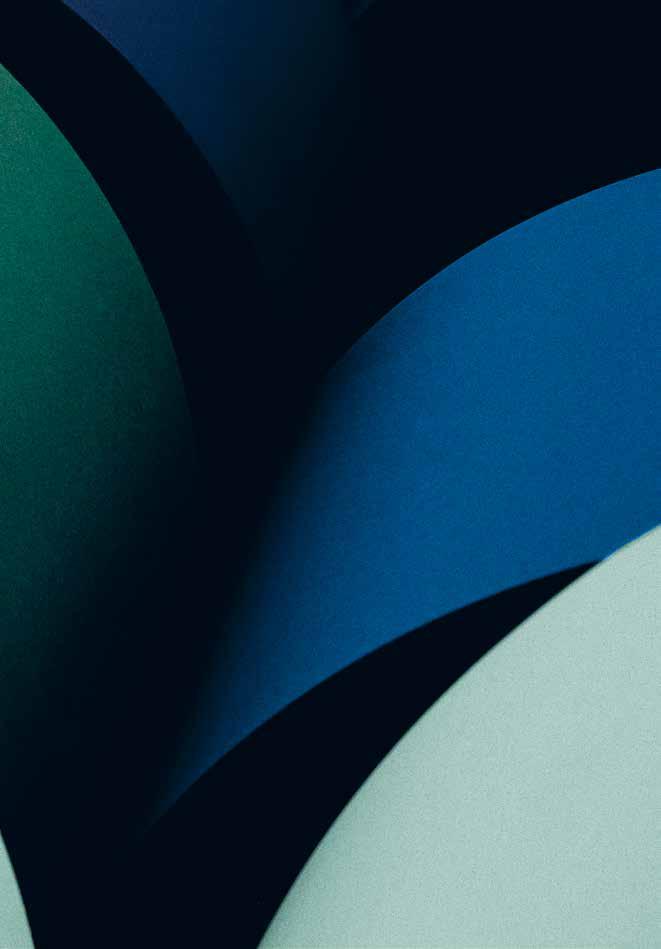
Can you feel it? Hear it? Smell it? This paper was produced by Gmund. For almost 200 years, the paper factory has been the hallmark of uncompromising quality.
Print is under pressure. For years, the printed circulation of daily newspapers and magazines has been plummeting. At the same time, the demands on paper production to reduce water consumption and wastewater are on the rise. Not to mention the spiraling energy costs. That’s where an established business model quickly becomes a burden. Not so at Tegernsee. Gmund Paper specializes in high-quality papers and excels with sustainable production and innovations, such as a paper made from hemp fibers.
Hemp provides more biomass than any other domestic crop, it is harvested three times a year and yields four to five times more paper than a forest area of the same size.
“We are always on the lookout for innovation – that goes for the entire company,” says Managing Director Florian Kohler. These “extraordinary steps” include, for example, that Gmund is the only company to process industrial water chemical-free with the help of ozone. Environmental protection guarantees the preservation of highly qualified jobs in the Bavarian Uplands. In 1829, today’s Büttenpapierfabrik Gmund GmbH & Co. KG was built on the banks of the Mangfall River and has since kept adapting to the course of time. “Innovation by tradition,” says company spokeswoman Sabine Huber, explaining that ideas are solicited, discussed, tested and eventually implemented. This is part of the company’s philosophy and part of how new papers or unique combinations come to life, she adds. Like the public restaurant “Mangfallblau”. Huber speculates that Gmund is probably the only paper factory with its own restaurant. By the way, Tripadvisor reviews of “Mangfallblau” say: “excellent food, very tasty cappuccino from an excellent barista.”

A P E R C A N OD HT A T .
While classic paper media are losing ground, Gmund has added high-quality papers to its portfolio. These are used to produce premium brochures or catalogs, but mainly packaging. According to Kohler, this presents an “immense growth area,” as paper is increasingly replacing plastic in response to the demand for sustainable packaging solutions. Paper with superior haptic quality is increasingly being used for printing. This can be felt: The paper crackles, rustles and chirps while the fingertips run over its surface. “Emotions can only be conveyed through haptics,” Kohler be -
lieves. That’s why companies are turning “more and more to high-quality design papers. The paper becomes brand ambassador. Gmund offers hundreds of different paper designs in the “Gmund Compendien”, starting from one sheet. In the “Gmund Creative System,” the company from Upper Bavaria supplies some staggering thirty thousand variants, starting from one thousand sheets. For orders of three tons or more, Gmund will even develop a very special customized branded paper, a one-of-akind with its very own color, structure and feel.
The paper manufacturer is also pushing innovations in environmental protection. Whoever thinks that when it comes to paper, there’s barely anything left to improve, let alone change, should really lay their hands on the hemp paper: 100 percent made in Europe. “The long fibers of this novel material make it firm in its structure, soft in its feel and wild in its look,” Kohler explains, adding: “Gmund hemp is produced without colorants – a real gamechanger.”
Paper manufacturing is a highenergy operation, which is why paper mills are located near water. Also in Gmund, the paper mill of the same name was built directly at the Mangfall River, which winds its way out of the popular recreation lake Tegernsee. The paper factory is located at the exit of Gmund. Almost 200 years of industrial history are reflected there, altered, modernized – and always up to date. Gmund has been FSC ® certified since 2006. “Conserving natural resources and acting eco-consciously is our day-to-day routine,” says Kohler. And there are reasons why production continues in Bavaria at all: Without constant investment in environmental protection, Gmund would also have fallen victim to structural change. We are now prob -
ably the only paper mill to obtain 100 % of our electricity from hydropower. The company uses sustainable raw materials, separates waste and reduces its water consumption on an ongoing basis.
There is no standstill in times of change: At the Gmund Campus, a team of specialists from the fields of fiber technology, material analysis, paper production, ecology, print and packaging technology, sensing technology and green communication advise new and old customers in the “Greenfibra Labs”. Upon request, the team of packaging specialists, designers and production managers will also turn the jointly developed paper into shelf-ready packaging or a customized direct mailing. It appears as though even after nearly 200 years, the story of Gmund Paper is far from finished.


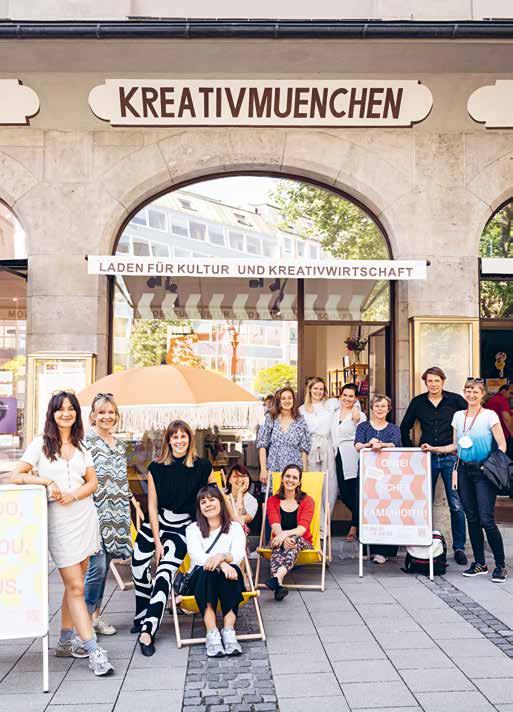
As a final collaborative project, the first-generation Ruffinihaus community displayed their works at the kreativmuenchen store on Rindermarkt.
MRUFFINIHAUS
UAmélie Graef has painted a wall right away. In Eyeshadow Purple, the color of her web presence. The graphic designer and illustrator shares the office with a colleague. They have moved their desks together in the center of the room, with stacks of books, computers, screens and a thermo bottle of tea on top. Most of the time, the door will be open anyway, Graef announces. She is looking forward to sharing ideas with the three dozen creative people who (co-) work on the second floor of the newly renovated Ruffinihaus. Open doors constitute an invi -
tation to all the architects, artists, filmmakers, designers, photographers and music producers who will inspire, challenge and support each other in the heart of the city over the next two years, says Britta Buck, who has been in charge of the project since the beginning of the year as part of the Kompetenzteam Kultur- und Kreativwirtschaft (Team of Excellence for the Cultural and Creative Industries, #kreativmuenchen in short).
The Ruffinihaus – a city-owned property – is a very unique place, a creative hub for Munich’s cul -
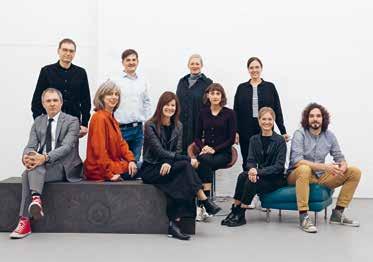
CThe Team of Excellence for the Cultural and Creative Industries operated by the City of Munich as a service to all cultural and creative professionals in Munich and the Metropolitan Region.

Since December 2020, the second floor of the Ruffinihaus has been a collaborative working space for the cultural and creative industries. Over a period of two years, self-employed professionals and business owners are given the opportunity to pursue their projects and take the next entrepreneurial steps with the professional support of the Team of Excellence for the Cultural and Creative Industries.
tural and creative industries. After being carefully curated in a two-step selection process, the second generation of companies from the most varied creative industries is just moving in. Now these companies are expected to thrive in a friendly co-creative environment and, in the best of cases, join forces to become a mutually inspiring community. The magic of the place is certainly helpful, with its historic staircases, the parquet floors, the strong walls, the two conference zones named “Collaboration” and “Conspiration,” and the support of the Team of Excellence as well as a community manager. The first generation has already found it to be working: Companies have improved their business models and have prospered. New products and services have been rolled out. And plenty of new office communities and friendships have emerged.
The “onboarding” is still in progress, says Buck. The new names are pinned to the overview board. For 20 euros per square meter, a wide variety of people with the most diverse skills are settling in: newcomers and seasoned pros, digital natives and less tech-savvy players. Organizational experts call that synergy. The first posts and requests such as “Need hammer, offer cake,” but also “I’m in the middle of the start-up process, anyone else as well?” are whirring through the in-house Slack Channel. 36 people who all want to build something together.
Ruffinihaus is a project of the Kompetenzteam, designed to provide experimental spaces for creative professionals in Munich. It also grants personal, free consultations on all day-to-day aspects of creative work, provides networking support for entrepreneurial challenges, and helps advance economic perspectives.
Experimental spaces are also at the heart of the “Munich Creative Heart Beat” (MCHB) project, which develops and brokers affordable studios, inexpensive office space and attractive gathering areas in cooperation with the private real estate industry. Within the Kompetenzteam, Anne Gericke is responsible for these types of real estate, which are often leased out for interim use: “The trouble is that many creative professionals, even the more established ones, are being forced out of the city center.” As a result, she says, there is a massive rush for viewing appointments. 1000 creative players are registered with the Kompetenzteam. “The diversity and the fascinating concepts of the players never cease to impress me,” Anne Gericke remarks.
For eight years, eleven specialists from the Kompetenzteam Kultur- und Kreativwirtschaft have been campaigning for “appreciation, visibility and financial empowerment of the sector” so that creative professionals can make a living from their work.
Olaf Kranz heads the Kompetenzteam. “Ruffinihaus serves as a pilot for us to determine what a Start-up Accelerator in the cultural and creative industries needs, as these kinds of accelerators operate differently in the arts and culture segment than in the tech industry. In turn, however, the tech field shapes the expectations placed on startups, such as rapid growth, scalability and exit with return on investment,” says the sociologist with a PhD. “With the RUFFINIHAUS Creative Hub, we also want to raise awareness for other success metrics and operating conditions for the benefit of the industry.”
It appears that the pilot project is doing quite a few things right. The Ruffinihaus is buzzing. Moving in and closing the door is not
an option here. That’s why one of the most important questions in the admission assessment was: Do you know the difference between co-working and community? The renovated offices are homey, the lighting is warm, and the hallways glow in a balmy mint. No one can excape the magic of the building. All he really wanted was a quiet corner for himself and his thoughts, says Dominic Ahn. But then the architect was “totally happy” to share the Ruffinihaus spaces with other creatives. Together with Matthew Dueck and Lukas Prestele, he founded the office “adpa” from there. A large model shows a preliminary project. In the countryside. The three partners laugh about the fact that they are building outside of the city, since they can’t imagine living anywhere but in the city, preferably in its very heart – just like the Ruffinihaus.

> Adressmanagement
> Responsemanagement
> Inkjet-Adressierung
> Laser- und Digitaldruck
> Adressausgabe
BAVARIA DIREKTMARKETING & FULL-SERVICE GMBH
Industriestraße 1 82140 Olching bei München
Tel.: +49 81 42/66 957-0 vertrieb@bavaria-direktmarketing.de www.bavaria-direktmarketing.de
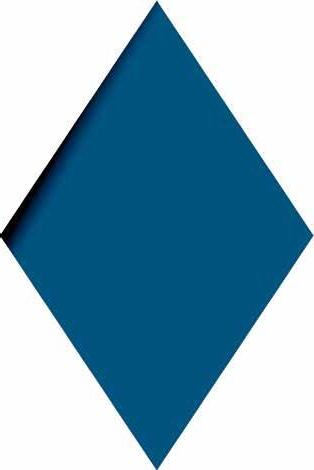
> EDV-Dienstleistungen
> Premiumadress
> Lettershop maschinell/manuell
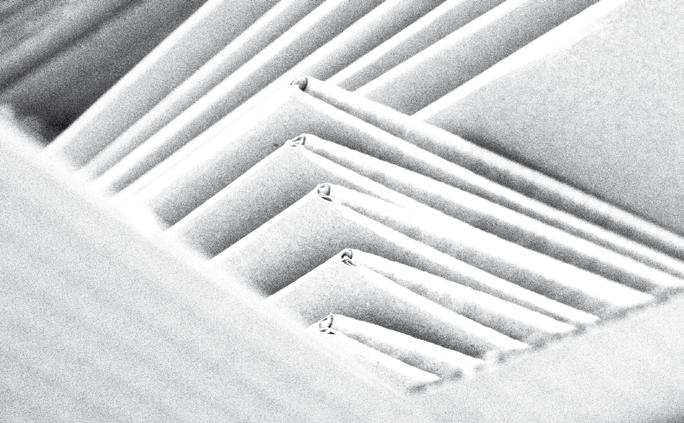
> Einschweissen/Folieren
> Telefonmarketing/Terminvereinbarung
> Fulfillment/Logistik/Distribution
> Werbemittel

The Munich PwC Experience Consulting Team
Transformation is a process, says Dominik Ueblacker. “You can’t just flip a switch and it’s done.” The 37-year-old is senior manager in the “Experience Consulting Team” at PwC Germany –in a sense, the product innovation department of the industry giant, which otherwise only employs auditors, tax advisors and management consultants. Sustainability is the axis everything revolves around for the 850 designers and technologists working for the PwC Experience Consulting Teams worldwide. Two dozen team members are based in Munich. “We don’t just want to design new products and services, but use them to improve the state of our planet.” To do so, the team has expanded, for example by bringing in a circular economy expert who has founded her own start-up dedicated to plastic avoidance. In addition
to concepts and digital processes, the team also creates practical products. It has its own prototyping lab in the basement. “We are hands on and also enjoy getting physical ideas off the ground.”
Change is the hot topic. Mobility, Health, and Retail are the industry’s focus areas. The team is working with a German car manufacturer on new distribution models, which amounts to a cultural shift for the company and its dealers. What can they offer if customers buy directly online? What services, what opportunities come from that? All touchpoints are being digitized. How that feels is currently being tested by the Experience Consulting Team “We do interviews, build prototypes, and if that works well, we put large development teams on it.” There’s still a lot of research to be done first. For one project, they are testing highway-related services, which involves talking directly to users on the road. They conducted dozens of interviews with truck drivers in Polish, Romanian and Ukrainian. They wanted to understand what is going on out there, and learned that for drivers, expensive restroom fees and unhealthy food at rest stops are serious challenges. A coincidental find? Quite the opposite, says Ueblacker. “We always go to those who are affected and ask: Who exactly is our target group, and what challenges do they have? And what are they looking for in the middle of change?”
In 2020, the innovation and design agency experienced first hand what change entails. The former IXDS, according to its own statement, “Germany’s leading innovation studio”, was suddenly a candidate for takeover. IXDS was absorbed by the management consultancy PwC. A major culture shock for many creatives. “Just imagine: a de -
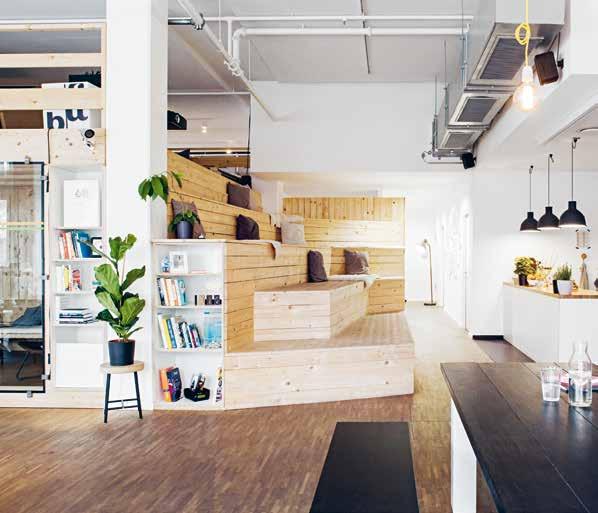
More than the creative playground of a large management consultancy: This is where ideas take shape.



sign agency joining a company with more than 13,000 employees, that wasn’t exactly a walk in the park,” Dominik Ueblacker recalls. Some left because they felt the transformation wasn’t for them. Others wanted to make a change anyway. Processes, routines, workflows – everything was adjusted. “Today, almost three years later, we have finally made it,” says Ueblacker, “as our own team known as the Experience Consulting.” The employees at the Munich-based Experience Center, one of 40 worldwide, want to move some big wheels. And the corporate giant PwC serves as a “door opener to riveting topics and projects,” explains Ueblacker: “PwC is right in the heart of the action. Especially seniors are intrigued by this combination of agency environment and consultants.”
Whether it’s the traffic turnaround, public transport or health: Germany is changing. Hence the field research. His team doesn’t just want to look at one person, but at the entire ecosystem, as the political sciencist explains. The goal is to identify entrenched thinking and disrupt old habits. It begins with the studio itself: “I have started doing the morning team call while I’m out walking. Just talking on the phone while I’m taking care of my mental health.” Ueblacker, who lives in the country with his two dogs, took a sixmonth sabbatical in 2022. In this regard, he quotes the American economist and organizational expert Warren Bennis: “There are two ways to be creative. One can sing and dance. Or one can create an environment in which singers and dancers flourish.” Ueblacker felt like he was the second guy his entire professional life and decided to “recharge and reboot.” Quite an appropriate image for the big transformation we are currently undergoing.

Alle Informationen und Anmeldung: www.stoff-fruehling.de
Arte • C&C Milano • Caparol Icons • Casamance • Christian Fischbacher • Colefax and Fowler • Création Baumann • Dedar • Designers Guild • Élitis • Ferreira de Sá • Fine Textilverlag • Fortuny • Fritz Hansen • Gebrüder Weishäupl • Hohenberger Manufaktur für Tapeten • Houlès • Hästens Beds • Interstil • JAB Anstoetz • Jim Thompson • Kobe Interior Fabrics • KT Exclusive • Kvadrat • Kymo • Lelièvre • Little Greene • Luiz • Mariaflora by Filippo Uecher • Nobilis Fontan • nya nordiska • Object Carpet • Perennials & Sutherland • Phillip Jeffries • Pierre Frey • Rohleder • Salzburger Handdrucke Jordis • Sanderson Design Group • Saum & Viebahn • Sørensen • The Romo Group • The Rug Company • Wall&decò • Werther - Die Möbelmanufaktur • Zimmer + Rohde • Zollanvari Internationale Textil- und Tapetenverlage laden nach München ein!
ADVISOR FOR THE CULTURAL AND CREATIVE INDUSTRIES AT THE GOETHE-INSTITUT HEADQUARTER
INTERIM PROGRAM DIRECTOR EIT CULTURE & CREATIVITY
What exactly does “disruption” mean to you?
ND
Disruption occurs when technology, competition and user behavior lead to a radical change in the market. At the Goethe-Institut, we are giving this topic a lot of thought. How are technologies like Deep Learning changing the supply and demand for language courses? What will the library of tomorrow look like? What is a reasonable carbon fingerprint for tours, co-productions, and mobility programs in light of climate change? As language and cultural educators, we need to provide answers to these and many more questions to remain relevant well past tomorrow.
How do you motivate your team, and vice versa?
ND I have a three-year-old daughter, and watching her everyday I see what motivates her. She wants to feel autonomy. She wants to experience competence, she wants to explore purpose, and she has a desire for social inclusion. If we pay attention to these points as a team
and as an organization, we can be sure to have highly motivated people in place who can accomplish a lot together.
What do you like about upheaval?
ND
I like upheaval because it challenges us and takes us to a new level of professional or personal development. Yet we shouldn’t ignore the downsides of permanent change either. Gen Z and A are increasingly voicing their concerns about how we as a society can succeed in preventing growth, acceleration and permanent change from inevitably leading to alienation and climate catastrophe.
Hartmut Rosa introduced the concept of resonance: Upheavals are compatible with a good life when they allow us to relate to the world through them instead of being chased by them. Music, literature, visual and performing arts are, in that regard, “resonance machines” and possibly the best guides through times of upheaval. That is why cultural institutions like the Goethe-Institut and design platforms like mcbw have a social responsibility.


CREATIVENL EXPERT, WITH FOCUS ON GERMANY, FOR THE DUTCH TOP SECTOR CREATIVE INDUSTRIES
Do we talk too much about disruption?
CW
I am never tired to talk or think about disruption! Living in a country below sea level, we always have to be aware of suddden changes. Our Dutch creativity, pragmatism, entrepreneurship, openness and collaboration might bring contributions to societal challenges. The Dutch creative industry is characterized by quality, functionality and the urge to innovate to have a social impact.
How creatively do you deal with change?
CW
In the Netherlands, we say: We all have a responsibility, and we have to do it together. We want to work with Germany to find solutions. Dutch design contributes to solutions for challenges all countries are facing today in the areas of renewable energy, the climate, health, mobility, and security such as safely living in a city. Our focus on circular design and sustainability solutions has been chosen in line with the UN’s Sustainable Development Goals. CreativeNL is working on
a more in-depth view into this topic. It concerns the search for future-oriented and sustainable solutions to global challenges, and the development of processes and products that leave no negative footprint for people or nature.
What do you like about transformations?
CW
Transformation is always going on. Our parents witnessed the internet emerging. The newest transformations for the next generation – because of Artificial Intelligence and other technologies – will come quicker and quicker and have more impact on our social life than ever before. We have to ask ourselves: which type of society do we want to be? Are we able to keep the societal happiness we have? Will we be the “slave” of the profits a country can make, or will we keep in mind the importance – above money – to protect and keep the society we have today, built on trust and cooperation? That dilemma will be a challenge. I – and we as Dutch – strongly believe in the human-centered approach. In any transformation.
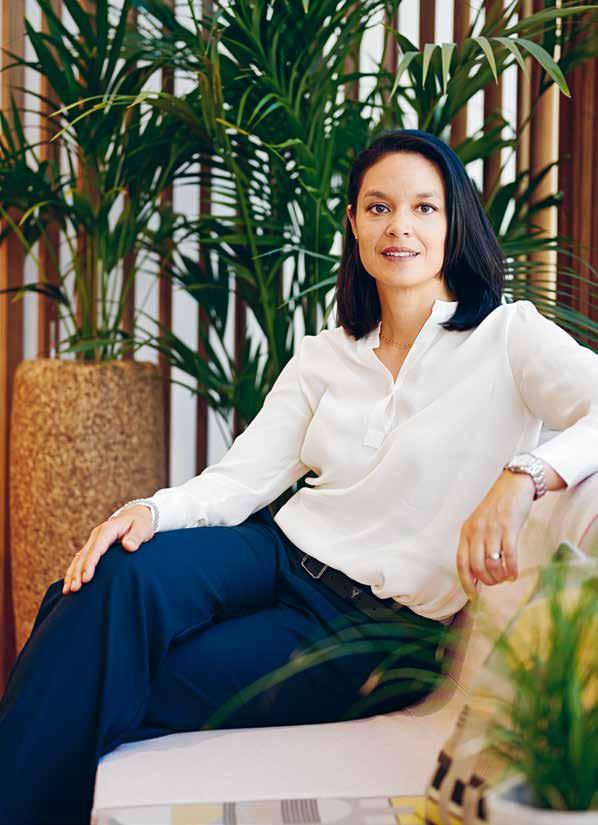
Everybody is raving about agile structures, flat hierarchies and mixed teams. For the longest time, the lounge was deemed the ideal image of that. Will this continue to be so?
In most people’s perception, the lounge stands for an agile modern company. That said, I don’t think the lounge is the ideal image for that. All too often, fluffy sofas or oddly matched chairs serve primarily to score points for external appeal. But without a carefully conceived workspace design, these areas won’t be frequented and fail to serve their purpose.
OH How so? FM
Especially interstitial spaces are becoming more and more important in workspace design. Design facilitates collaboration, boosts motivation and engagement, and meets the needs of a multigenerational workforce. Even a power source nearby can make a difference. Couches with adjustable seating depth and decent back support, plus a laptop table within arm’s reach, become multifunctional: perfect for a quick team update, informal exchange, creative workshop, or for changing to another work setting.

OH
Is it possible to promote creativity through design at all?
DEWI SCHÖNBECKDesign can definitely help to unleash and nurture creative potential. The results of our re -
search show that in addition to rigid corporate processes, acute workloads and lack of technology, uninspiring work environments also have a negative impact on creative work.
OH
And how can an office become an ideal space for creative processes?
DS
Creativity is one of the most valuable resources of innovative companies. An efficient working environment is tailored to the needs of its users. It is supportive and not disruptive –because maybe there is a loud phone call at the neighboring desk and I have no choice but to move to another spot to complete my focus work. In today’s daily work routines, hybrid design concepts are a must. The office has to be equally suited for hybrid and on-site collaboration. Whiteboards and large collaborative screens are called for so that colleagues who work from a different location can also be integrated.
OH
So it’s about choices?
DS
Precisely. Employees need a set of environments to choose from for their varying activities – and to be in control of their choices as they see fit.
OH
Does disruption and change unleash creativity?
FM
Absolutely. We humans are creatures of habit and find it convenient to hold on to the status quo. Naturally, nothing truly new ever
emerges from that, whether in personal or professional contexts. But when we break out of the routine and leave our comfort zone, we have to take action and get creative. We can all become the designers of our own and our society’s future. Also, the current trend toward “hybrid work” was actually really set in motion by a disruption: the pandemic.
OH
Meanwhile, the boundaries between home office and “office home” are getting blurry. What will be the next big disruption?
DS
Looking to the future, we see the growing need of employees for flexibility and options – with regard to office design, work location or work model. For companies, this means figuring out how to make the office more attractive so that people will enjoy coming to work. As our latest research shows, employees want more privacy and quiet spaces for retreats in the office, and some even want their own dedicated workspace.
OH
This means that organizations that have opted for openness and transparency will have to undo everything?
DS
Not at all. It means that we need to create versatile work environments that allow people to feel comfortable and find the workspace that suits them the most. Designing identification, diversity and variability is, and will remain, one of the major future challenges that companies will have to address.
Which role does creativity play in your company?
MZ
We believe in the power of creativity. It enables us to make the future visible, to make it better and more livable. Progress originates from creative energy. It’s about striving for improvement, simplicity or sustainability. So our creativity is not just our attitude: It is our profession. It propels in us a particular mode of expression that makes us stand out. We use it to convey issues that usually can only be described through language on a conceptual level, such as health, sustainability or mobility.
How do you as a company handle upheavals?
MZ
When you look at our logo, it immediately shows that we seek to redefine upheavals: To us, upheavals always stand for change that gives rise to something new. The old no longer applies. To see an upheaval coming at an early stage and to transform it into a fresh start to shape and implement the new – that is our true
challenge and our job as designers. Upheavals always give way to new viewpoints, they call for a change of perspective and define a new context. And we can only describe this context once we engage with it. This is the most exciting phase for us as creatives. And that is precisely why we advise numerous companies that are undergoing transformation phases and support them in their realignment until it is complete.
What was the last event that really caught you by surprise? And what happened next?
MZ
Obviously, the pandemic threw us off guard. However, we perceived it as an upheaval that entailed progress: We used that period to start scrutinizing our organisation and to define where we saw ourselves headed in the future. We tried out different leadership models and reorganized teams. Today, our structures allow for cohesion and autonomy in equal measure and they grant everyone the position they need for their creative work.
THREE QUESTIONS FOR
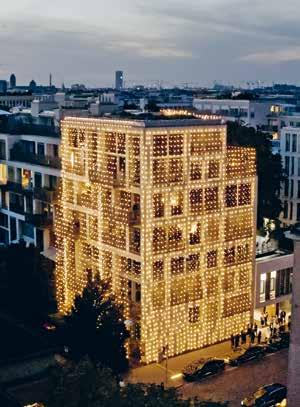
Making science more accessible through design.
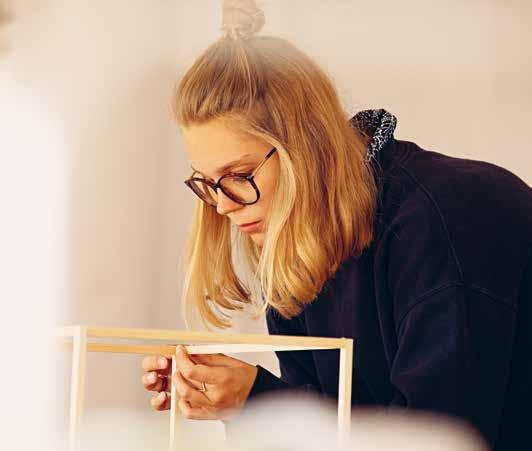
The globally interconnected Fraunhofer-Gesellschaft shows how.

In times of crises, fake news and alternative facts, science takes on a crucial role. Its expertise helps politicians to assess disruption objectively rather than on a gut level, and subsequently to make informed decisions. “We are committed to the facts,” says Welf Zöller, head of Dialogue Communication at the Fraunhofer-Gesellschaft. “These need to be presented in an understandable way. We’re already making good progress here, but we want to communicate our results and findings still more effectively in the future.” That’s why the non-profit Fraunhofer-Gesellschaft makes the abstract more accessible: for example, through interactive workshops, panel discussions or an exhibition of prototypes and visionary projects from the Fraunhofer “Science, Art and Design” network. Its spokesman,
Professor Jens Krzywinski, sees plenty of “positive friction elements” between the large scientific realm, which has yet to increase its cross-disciplinarity, and everything design brings to the table: “It’s a very fruitful relationship”, he says, adding that design helps in transferring knowledge to society. While seeming quite different at first glance, art, design and science complement each other. The industrial designer, who holds a doctorate in Engineering, wants to present science with a different narrative than before, with a lower threshold, and thereby get people enthused about the creative design of their world. But how can this be done? Is it merely a question of finding the right formats? Jens Krzywinski sees a disruption there as well: “We may have to get used to communicating multiple perspectives simultaneously.” Ultimately, it is not technology as such that solves our problems, but its responsible and targeted application for the good of our society. Design can act as a catalyst and a builder of bridges here.
Design expert Krzywinski and communications specialist Zöller are working on new formats for communicating even complex issues and intricate scientific positions to the general public. And obviously with success. The Fraunhofer “Technology Roof” held during the European Championships 2022 attracted 11,250 visitors over the course of five days. After all, technology affects everyone. Today’s knowledge society depends on science and research. Their technology keeps cell phone networks working and solar cells generating electricity. “Inventive genius is our country’s most valuable raw material,” is one of the guiding principles of the Fraunhofer-Gesellschaft. “It enables the efficient and sustainable transfer of scientific findings to the economy in the
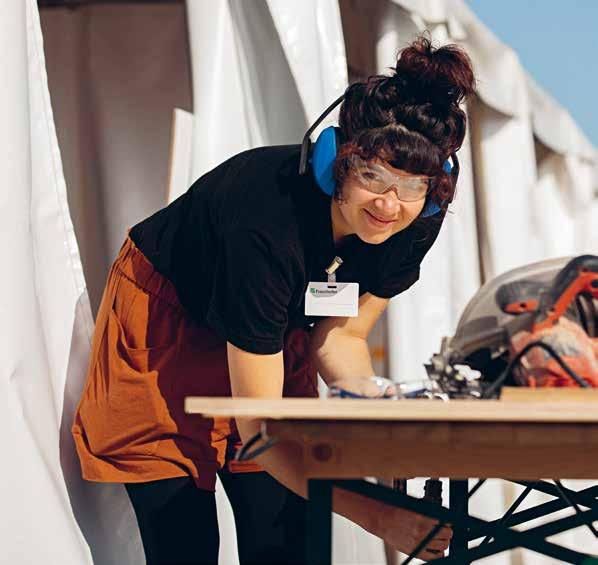
Cross-disciplinary cooperation formats as an stimulus for research – the annual Fraunhofer Summer Camp “Science , Art and Design”
World leader in application-oriented research.


first place.” Even more so in a world full of disruptions – from COVID to AI to cybersecurity and medical imaging. With its focus on key technologies, the Fraunhofer-Gesellschaft is very much a driving force for change itself: It transforms disruption into productivity. The FraunhoferGesellschaft is a major international generator of knowledge. With 76 institutes and research facilities and 30,000 employees, it accounts for an annual research volume of approximately 2.9 billion euros. About 70 percent of that comes from the field of contract research, i.e., from contracts with the industry and from projects with public funding. Since Fraunhofer works on a non-profit basis, any surpluses are being reinvested directly to promote and support science.
At the mcbw in Munich, the Fraunhofer-Gesellschaft is participating with its own showroom and a living lab. “Our ambition is to not only promote science with our work,” says Welf Zöller, “but to be a contributing force for our society in transformation.” In addition to making new contacts within the design community, he aspires to enthuse people with more artistic interventions, among other things, and to use the increasing design expertise within the FraunhoferGesellschaft to convey the benefits of science. Examples could include insulating materials made from fungi, both innovative and sustainable building materials. Or high-performance solar cells. Or quantum computing. Or entirely new networks. Or music streaming, as the MP3 code is also a Fraunhofer brainchild. Jens Krzywinski also believes there is an answer to the challenges of transformation: more networking and exchange among artists, designers, researchers and society. Cross-disciplinary research clusters offer a foretaste of our future, where diverse teams will be the norm.
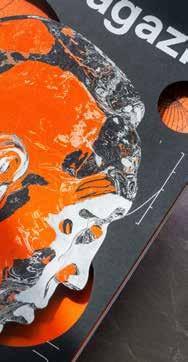
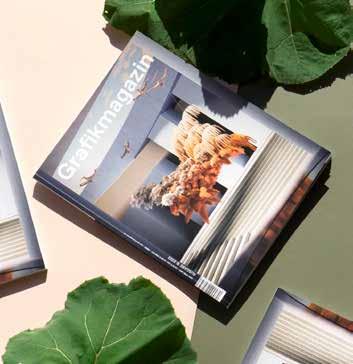

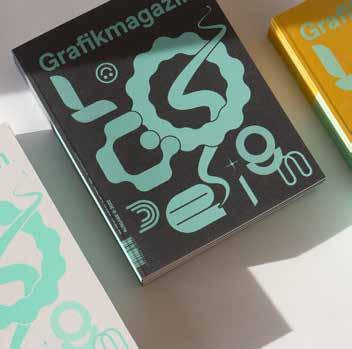

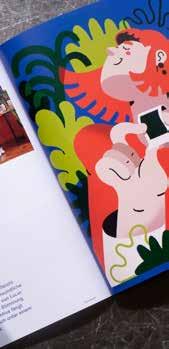
The munich creative business week (mcbw) organized by bayern design is Germany’s largest design event, which, for the twelfth time this year, will take place in Munich from 6 to 14 May 2023. With its diverse high-caliber program, the event is addressing the design-interested public as well as a professional audience. In fact, the challenges of recent times have shown how important fresh stimulus and a cross-discipline exchange is for creative professionals, for the economy and for society in general. With a broad array of events, exhibitions, talks and initiatives all across Munich, the mcbw 2023 facilitates encounters, promotes an interdisciplinary dialog and provides inspiration in line with the motto “Why disruption unleashes creativity”.
Why isn’t the mcbw simply called Munich Design Week?
LB
We actually get asked that a lot. And at bayern design, we also ask ourselves this question on an annual basis. It comes
up every time we reflect on where we want to take the mcbw and how we can develop it further. Yet each time we deliberately come to the conclusion that its name must remain exactly the same: munich creative business week. Because the term “business” incorporates that very aspect that distinguishes us from other design weeks. The mcbw is not just about the presentation and display of design. It’s about design in all its facets, depths, but also its needs.
The term “business” might carry some negative connotations, as it is usually associated with purely economic and financial aspects. But there is so much more to it: Business implies the exchange of deep knowledge, networking among experts, sharing expertise, making innovations visible, so that concrete formats, projects or even a classic business or business model can emerge. So business is of fundamental importance for designers and creators.
If mcbw were a cake, what would it be?
LB
A colorful glazed multi-layered cake.
Because you first have to cut through the surface and the icing to get to the many different layers and fillings. Those can all be sweet, fruity or even bitter at times in their own way, but they deliver a delicious taste altogether. You can’t eat too much of this amazing cake, mind you, but you can’t wait to try it again.
It’s the same with the mcbw. You have to explore it in its full depth. At first glance, you see just the surface and the shell. It’s not until you take a closer look, sniff around and try it out that you will discover the mcbw’s true wealth and joy. This
sometimes takes time and effort, but it ultimately pays off. It is so worth it to check out the smaller and less popular formats or names to discover something new that will unfold a lasting impact on you. After all, not everything looks the way it tastes on the finish.
What motivates you to show up for the mcbw every year?
LB
I am motivated by the different examples of design, styling and creativity. And I am often impressed by the small projects that tend to have a harder time to be visible.
I get inspired by the conversations with the people behind the products, business models and stories. And most of all, I find their passion for their work and for their endeavors highly contagious. I like the determination the designers put into their work, not letting anything get in their way and consistently pursuing their path, with all the ups and downs or even detours. And when I sense this motivation in others, I realize that this is exactly what the mcbw is for: making this passion and motivation tangible by making the great variety of ideas and projects visible at the mcbw.
What are the thoughts of the mcbw advisory board on the big upheaval? How creatively do designers deal with change? And: In a world of change, even a little consistency can have a disruptive effect.
Is this still change or already the great upheaval, the digital tipping point so many fabulate about? Either way, it feels like more than a simple transition from the analog to the interconnected digital world: Artificial intelligence paints pictures from words and writes essays on all kinds of topics. And it’s not bad at all. At the same time, certainties break away: We wear masks at the doctor’s and have a war going on in Europe. Disruption may be a buzzword, one that pops up at any
given occasion. But it pretty much captures the transition from an organized system to an increasingly chaotic mess that requires flexibility and fluid thinking in order to respond appropriately to the multitude of changes. How much newness should there be? How many disruptions, interruptions and shocks can we handle? In other words, how big is our comfort zone as long as we think that we always want something new, but we don’t really want to change anything, least of
all ourselves? Let’s take a look at the creative industry: How do designers handle change?
Cut!
Time to reconsider. We need disruption, leaps in development and small nudges. They help us progress. Evolution only happens as a consequence of permanent disruption, as futurologist Matthias Horx explained, and we also need the occasional stumbling block. When something doesn’t go as smoothly as planned, when we are disturbed in our regular daily routine, that’s not the end of the world, but often just the beginning of a new thought. Because the present time makes one thing abundantly clear: Control is an illusion. In the future, it will be much more about dealing with uncertainty and ambiguity. Disruption is hence nothing but an expression of the fact that we should be dealing with a change that we can neither control nor reject ourselves. We need to position ourselves in the face of permanent change. Disruption thus becomes a breeding ground and a catalyst for creative processes. It leads to innovations. And hopefully to improvements. Disruption presents an opportunity for a society that likes to rely on what has been tried and tested. “This is how it has always been done” is no longer good enough. Now that the world is falling apart and we are being deconstructed as well, we might as well reassess the status quo and rebuild the world in a different way. And so, disruption is turning into a friend of creativity and innovation.
Cut.
Design keeps developing creative innovations that cause or respond to small or major shakeups. Its inherent strengths lie in dealing with not knowing, not being capable, and even failing. And the very
act of dealing with uncertainty is an essential part of the design process. This gives rise to an attitude that goes much deeper than a Design Thinking workshop would lead us to believe. To put it bluntly: Design in itself is a destructive field of work. Because whenever it creates something, it simultaneously destroys parts of what was there before, what already existed. In this respect, design is both disruptive and preserving. This concerns innovations as well as identities, traditions as well as transformations. For this reason, design is the key discipline in mastering the major transformation tasks for companies, politics and society. It is at the center of innovation processes, interlinking various stakeholders. In a nutshell, design is the genuine driving force for change and transformation. The new is no longer exhausted in designing technical products. Instead, it involves new processes, changed cultural patterns and new forms of communication and coexistence.
Cut.
So what does this mean for our response to change in a world of accelerated transformation? All of a sudden, even a tiny bit of consistency can have a disruptive effect, as it’s sort of disrupting the disruption. It questions the cultural patterns of our modern age, which propagated constant acceleration and expansion and thus contributed quite significantly to the problems we are facing today, first and foremost climate change. As ambivalent as disruption may seem at the moment, it can stimulate creativity, just as design, in turn, triggers disruption. We will have to live with that in these times of accelerated change. Cut.
Discussion panel of the mcbw advisory board featuring Professor Markus Frenzl, Boris Kochan, Professor Dr. Angelika Nollert, Dr. Dewi Schönbeck and Hannes Ziesler.
With the relaunch of our website, bayern design is making itself even more available to the design community. The website bayern-design.de features current themed articles, events and cases from bayern design or the community.
This has not only repositioned the bayern design brand with its brand values of openness, optimism, and commitment: Also the leitmotif “design connects” has been made palpable and perceptible.
Both leitmotif and brand values are a recurring feature throughout the elements of the design system, which was created by the Nuremberg-based agency Die Krieger des Lichts (DKdL). The new look is characterized by a light, playful and clear graphic language, which primarily uses particularly striking overlapping effects with the radiant colors red and blue to be constantly interpreted in everchanging combinations.
Creative service providers with an affinity for design (offices, agencies and freelancers), companies and institutions from Bavaria and beyond can actively contribute to the bayern design website with their own articles and present themselves to relevant target groups. The mcbw program partners and members of the sponsoring association bayern design forum e. V. can create a detailed profile with picture and logo and publish their own expert content. Members also benefit from free job offers and event information.
The community area also provides users with a tool for finding creative services as well as project partners from science, business and the craft trades. This makes the bayern design website not only an information hub for all things related to design and design promotion in Bavaria, but also an ideal platform for the networking activities of a growing design community.
Register on https://bayern-design.de/community/ to join the bayern design community!

What new materials are needed today and in the future, and how can they be produced and used in a particularly sustainable way? The design exhibition “Material+” at the Neues Museum Nürnberg from 21 April to 3 September 2023 addresses these questions by means of research projects, applications and speculative designs.
New materials have always held great importance for the design discipline. However, the confrontation with resource
scarcity, climate and biodiversity crises also prompts designers to reflect more deeply and with renewed urgency on the use of materials. Ecological requirements along with their social and economic conditions are placed under the spotlight.
In three chapters, the exhibition shows selected objects in which new materials have been researched and applied as sustainable production materials and design elements. The exhibition looks at different aspects of the material cy -
cle, resource extraction and processing, application and use to recycling or reintroduction into the environment. Here it becomes clear that sustainable design not only focuses on the selection of new materials, but always considers the entire materials cycle as well.
In the six glass façade rooms of the museum, applications and research proj -
ects involving innovative materials made from fungal mycelium, cellulose or recycled plastics are on display. The exhibits range from furniture by Stefan Diez or Tom Dixon, bowls by Studio Klarenbeek & Dros or crafting plastics! to car seats by BMW.
The exhibition is curated by bayern design. A joint exhibition of the Neues Museum with bayern design.

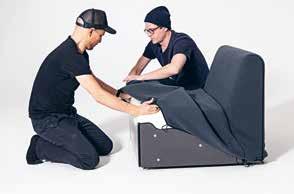
Social Design is the overcoming of both social and societal as well as economic challenges by means of design. Design theorist Horst Rittel described these issues from the mid 1960s as “wicked problems”; problems where the solutions keep creating new problems. Or, problems that are too complex to be fixed with one single solution, but instead require an ongoing process of solutions and adjustments. How creative solutions to these “wicked problems” can always be found in a world rattled by disruption will be showcased by bayern design at the mcbw 2023 and beyond in their annual program spread throughout Bavaria. Here, the focus lies on the role of design and the responsibility of designers.
Since these “wicked” problems always emerge from a social context, they require solutions that are designed in a multi-perspective approach and explored
by a large number of stakeholders. At the heart of these Social Design processes are social innovations that need to be designed in a participatory and democratic way from the bottom up.
In the coming months, we will be exploring with experts the contribution of Social Design to the emergence of a world that is increasingly worth living in.
bayern design is the brain behind the mcbw. As an economic development institution, the international competence center for knowledge transfer and collaborations around design in Bavaria primarily addresses the business community and mandated designers. This, however, is hardly possible without close cooperation with colleges and universities. That is why bayern design is partnering strongly with these and other stakeholders invested in design research. For years, bayern design has therefore been promoting the scientific exploration of the topic of design with the support of the Bavarian Ministry of Economic Affairs, thus making sure that the results of this research also benefit the Bavarian economy in helping it master the transformation tasks that lie ahead.
Examples include the 2013 study “Do you speak Design?” on design communication in and by companies, the 2017 study “Make – Design – Innovate” on the poten -
tial of the Maker Movement for the economy and society, and in 2018 the web app “Design Pilot.” The tool supports designers, managers and engineers in the cross-discipline development of products and services, while also covering the processes that follow the initial brainstorming. In 2022, bayern design commissioned a “Study on the Economic Relevance of Design.” In addition, the new bayern design website features expert contributions by third-party authors providing a compact overview of the most recent design knowledge.
In cooperation with universities and political institutions, ways are being sought to promote the next generation of scientists in Bavaria. At the mcbw, this close alliance becomes particularly apparent: Here, players such as the universities can publicly engage with the industry and initiate the much needed dialog with the economy and the political sphere. All in the interest of a future-oriented society!
BARBARA DE LA JARA
Partner Management mcbw
The personal recommendation of the bartender: different every time and always a positive surprise.
Head of mcbw
KARINA IGLHAUT
Project Management mcbw
Surprising nuances, smooth finish, invigorating effect – the mcbw frizzante: 2 cl set-up, 2 cl fun, 6 cl inspiring people, 1 amazing city, ice cubes.
A drink with depth that must be savored two or three times before you can fully appreciate and taste it in all of its facets.
Head of Public Relations
Bitters are the essential ingredient in drinks. Gin, Campari or Tonic water are indispensable, as are serious topics for the mcbw. So for me, it quite resembles the Negroni with its bittersweet taste.
MIRIAM WOLF
Public Relations
A strong, spicy-sweet chai – brewed with utmost care from handpicked ingredients and served in a colorful shimmering glass.
Head of Finances and Office Management
A good cognac, a blend of different brandies, which in its entirety rounds off the experience.
Head of Projects
Thirsty for knowledge, sometimes reeling, (almost) intoxicated by the mcbw.
Managing Director
A light gin and tonic with ginger, blood orange and cardamom – refreshing, mildly bitter, not too sweet. An energy kick with a gentle buzz of inspiration ... like at the end of the design week.
YVONNE ECKERT
Project Management mcbw
A Negroni. Casually elegant with fairly small headroom in the classic sense. Arrives at completely new twists by experimenting instead.
Finance Management
A Mojito. Refreshing and mildly intoxicating from all the insights and inspirations.
Project Management
A refreshing signature cocktail enjoyed in large circle in good spirits on a warm spring evening. Plus: plenty of good creative conversations.
Conception and Program Development
A superfood smoothie – the mcbw is a delicious fusion of fresh and creative perspectives!
Project Management
A homemade lemonade, served on a sunny spring day on the banks of the Isar with a couple of lemon slices on top – sparkling, refreshing, with a spritz!

Organizer
The munich creative business week (mcbw) is organized by bayern design GmbH, the competence center for knowledge transfer and collaborations in the field of design in Bavaria. With a host of different projects, it emphasizes the importance of design and its key role in managing economic, social and sustainabie change. It supports the implementation of the Free State of Bavaria's design funding and promotes the networking of designers and stakeholders from all disciplines, companies, universities, institutions and associations. The programs of bayern design GmbH are supported by the Bavarian State Ministry of Economic Affairs, Regional Development and Energy. mcbw is additionally funded by the City of Munich. The BMW Group, Steelcase, Ströer, as well as Gmund provide substantial support as mcbw partners.
Publisher Nadine Vicentini Managing Director of bayern design GmbH
Authors Oliver Herwig, www.oliver-herwig.de bayern design hw.design, Frank Wagner and Sigmund Perner
Concept, Editorial work, Design hw.design
Türkenstraße 55–57 80799 Munich www.hwdesign.de
Artwork and lithography
Oliver F. Meier
Production
Katja Knahn, www.paperkate.de
Paper
Cover: Gmund Bio Cycle, 300g/m²
Text block: 120g/m²
Printing and Binding: Gotteswinter und FIBO Druck- und Verlags GmbH Munich
Editor Mirko Partschefeld, www.lectorare.de
Translator Katrin Engelmann
Press office
Patricia Biebrich
NICKL PR
Goethestraße 25 A 80336 Munich
Phone +49 89 4807103
E-Mail pressoffice@mcbw.de
When using image and text data, kindly send us a link or a sample by post or PDF.
Info mcbw website: www.mcbw.de
Instagram: www.instagram.com/munich_ creative_business_week
LinkedIn: www.linkedin.com/showcase/ munich-creative-business-week/
Info bayern design website: www.bayern-design.de
Instagram: www.instagram.com/bayerndesignconnects
LinkedIn: https://www.linkedin.com/ company/bayern-design-gmbh/
Photo Credits
All image rights remain with the respective partners, except: pp. 13 – 17 BMW / Sascha Tassilo Hoechstetter; p. 26 MUCBOOK / Ramon Brussog; p. 30 Diana Weidmann; p. 46 Jana Schwerdtfeger; p. 54 Rache Go; p. 56 SixtyEight Art Institute Copenhagen; p. 56 Studio Catherine Sarah Young; p. 58 Kristina Grommes; pp. 62 – 65 The Helen Hamlyn Centre for Design / Ezzidin Alwan; p. 68 IDEO; p. 80 BECKER LACOUR; p. 85 Matthias Ziegler; p. 86 Ingmar Kurth www.ingmarkurth. com; pp. 90 – 93 Gmund Papier; p. 97 LHM Michael Schinharl; p. 93 LHM Dominik Parzinger, Marie Julie Lörch; p. 103 PricewaterhouseCoopers GmbH Wirtschaftsprüfungsgesellschaft; pp. 105 – 106 PricewaterhouseCoopers GmbH Wirtschaftsprüfungsgesellschaft / Verena Kathrein; p. 106 PricewaterhouseCoopers GmbH Wirtschaftsprüfungsgesellschaft / Savannah van der Niet; p. 109 GoetheInstitut / Sonja Tobias; p. 110 Sheltersuit Foundation www.sheltersuit.com; pp. 113 – 116 Chris Mueller, www.eyeamchris.com; pp. 121 – 123 Fraunhofer IVI; p. 124 DesignLab for Applied Research; p. 133 Robert Brembeck, Design Friction Lab
We apologise if, despite careful research, not all image sources may have been named in full.
WHY
DESIGN IST MEHR ALS FORMGEBUNG
Design verleiht Identität und strategische Klarheit. Design entwickelt Marken und Geschä smodelle. Design prägt Corporate Culture und Kommunikation. Design treibt Innovation und Wandel.
HOW
DESIGN BUSINESS DAYS:
WHERE BRANDS × CREATIVES MEET
Die Konferenz bringt CEOs, CMOs, Markenverantwortliche und Kreative in Design, Strategie, Kommunikation und Technologie zusammen.
WHAT
BEST PRACTICES, KEYNOTES UND DEBATTEN ZU THEMEN WIE:
• Strategisches Design × Business Design
• Brandmanagement × Designsysteme
• Co-Creation × Designmethoden
• Society-Centered Design × Sustainability
• Data × AI-driven Design
13 / 09 / 2023 in Hamburg / Hybrid
PARTNER

11–19 MAY
Alle Rechte vorbehalten. Alle hier genannten Marken sind das Eigentum von Steelcase oder dem jeweiligen Inhaber.
© 2022 Steelcase Inc.

Wir helfen Menschen, bestmöglich zu arbeiten - ganz unabhängig davon, wo die Arbeit stattfindet. Lernen Sie unsere Erkenntnisse, Möbel und Lösungen für optimale hybride Arbeit kennen.
steelcase.com/eu-en/hybrid